#i challenged myself to not use any textures or mirror the designs
Text
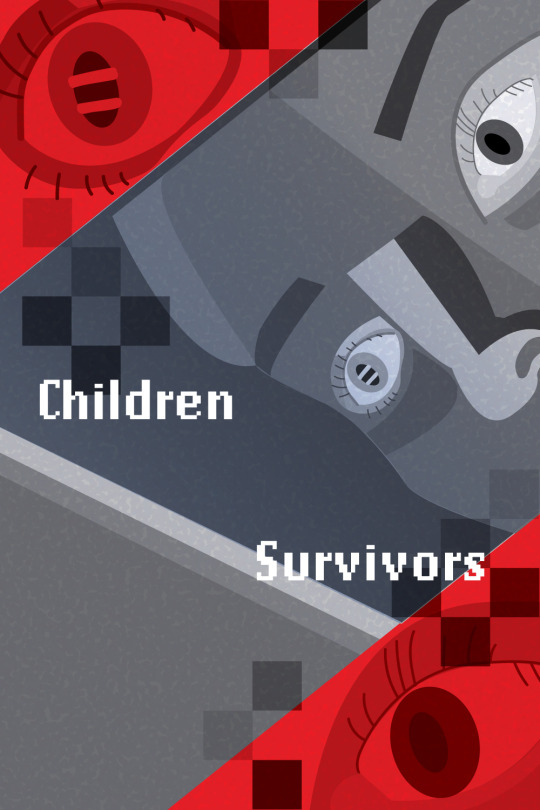
From switching between programs to chopping my work in half, this project has challenged me reinvent my design over and over again while narrowing in on my chosen concept: human trafficking. During one of our class critiques, it interested me to see which posters were awarded "most successful," and we found that these students had a clear, coherent theme which was celebrated by the design itself. As I continue to edit my colors, textures, and supporting design elements, I am reminded that anything of value must all be built on a strong mission: to convey my Same Difference concept. This is what gives every design element, color, and typeface purpose, and I was reminded of that today during my meeting with Professor Valdes. This is the first project in any of my design classes that I feel myself truly mark marking, as if I were painting. I find that the less scared I am of the working the computer softwares or creating something "incorrectly," the more I am able to have fun and focus on making my concept legible.
As for our weekly reading from Typographic Design: Form and Communication, I absolutely loved Jean-Benoît Lévy's posters, and I am very inspired by his use of angles, textures, and color gradients. In addition each one of his shapes has a purpose which transports the reader back to his intended message or concept. For example, his poster for a watch and jewelry store includes dots as planets alluding to the passage of time and movement of space: all things mirrored by watches. The book also includes a quote from one of Lévy's art teachers which I will never forget; "place type in the photograph rather than on the photograph." This philosophy contributes to his wonderful angles and spatial awareness regarding type in his designs.
0 notes
Photo

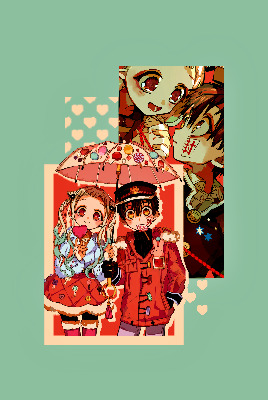
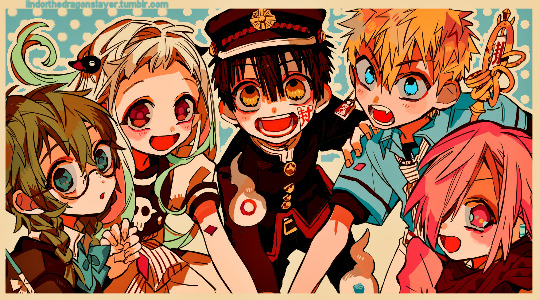

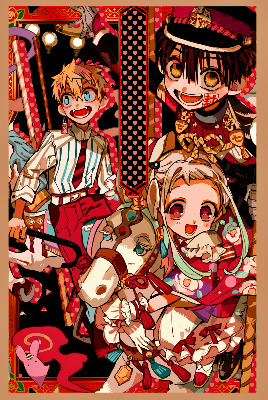
Let’s talk, number 7.
{ credits #00003 }
#jshkedit#jibaku shounen hanako kun#toilet bound hanako kun#yashiro nene#yugi amane#minamoto kou#mitsuba sousuke#manga#mineminemine#mine:anime&manga#mine:jshk#HEHEHE I'M QUITE PLEASED WITH HOW THIS TURNED OUT#i challenged myself to not use any textures or mirror the designs#and it turned out pretty okay if i do say so myself#i think i just needed a more cohesive colour scheme#i didn't really look at all the pictures together while i was making them haha
49 notes
·
View notes
Text
Wallflower
18+ ONLY
Ezra (Prospect) x F!Reader
Word Count: 4.2k
Warnings: fluff, mutual pining, cursing, smut, unprotected sex, oral (f receiving), masturbation, dirty dreams, implies age gap (reader is in 20s+/of age, just younger than Ezra)
No use of (y/n) in this one!
A/N: I know this was not one of the things I should be working on, and I procrastinated on my coursework yet again to write fan fic. I’m so in love with Ezra and I have wanted to write something for this character for a while. It’s my first time writing for him and I was so intimidated to write something about him because his manner of speaking is so unique that I’m worried I won’t do him justice! Hopefully you all enjoy!
Next thing I post will be the final part of Rest! It is currently in progress!
I will be updating my taglist form soon to include Ezra and other Pedro characters I write for so check out for that if you want to be tagged in future fics!
This is unedited and if I miss something to tag as a warning please let me know!
Tags and Requests and OPEN

“Ezra, for once can you please shut the fuck up. You’re driving me crazy,” you sigh, pulling off your helmet as you both return to your shared pod. It was a fairly long trek from the mining site back to your makeshift home and Ezra, being himself, talked the whole time- not once missing a beat.
“Not once have I ever had the pleasure of conversing with one as eloquently a sweet talker as yourself,” Ezra winks, making you roll your eyes. You weren’t actually mad at him, you could never, but one of the side effects of Ezra was limited moments of peace and quiet. In many ways, you and Ezra were very similar, and it made you really compatible partners.
But unlike Ezra, you really enjoyed quiet. Ezra, on the other hand, has had more than his fill of quiet for his lifetime and he basked in the ability to vocalize his every passing thought to you. It wasn’t often you felt the need to tell him to stop, but today had been particularly challenging and you couldn’t think of anything else besides the quiet of night and a good rest.
Ezra and you worked well because you were so much alike, but your differences also paired you two nicely. Ezra was without a doubt the biggest and most long-winded talker you had ever met and you were the best listener, opting to be the silent one in the conversation more times than not. You weren’t necessarily shy, just someone of a quieter nature. You mostly kept to yourself, by choice really, while Ezra struggled with solitude, it was one of the strengths of yours that you were able to endure it better than he could.
When you first met Ezra, he had called you wallflower, cause frankly you were one. Settled in the far corner of the pod with your notebook in hand, sketching instead of talking with the rest of the crew, Ezra made the effort to saunter over to you and made it his personal mission since day one to break you out of your shell. Made sure during mealtimes, he sat next to you, talked to you, asked you questions. Frankly, you owe the friendship you have with him now to his openness and talkative nature.
“Flower, I hope my parley on the trek back didn’t offend,” he says as he sheds off his suit.
“Not at all,” you say with a small smile, “Sometimes my meter runs out on my ability to listen. Tires me out.”
“I suppose I can understand,” Ezra replies, “I honestly seem to have the opposite problem, all my years in the Green, I never had the pleasure of someone to listen to besides my lonesome. Now that I have you, I find myself utterly unable to suppress my desire of spoken prose and I’m afraid I do tend to take advantage of your gentle nature.”
You nod, understanding him very well. It was coming up on seven months since you and Ezra had been on your own. The other three members of your crew had parted ways with you both, seeking out a better treasure.
Ezra, knowing what this planet and greed does, insisted on just doing his job and leaving, and you strongly agreed. It had been so long since the three of them went off for the buried riches, and you don’t even know if they will be returning to your pod at your scheduled time of departure in a few months’ time. Ezra told you stories about how he’s witnessed this job change people, and how he’s seen planets swallow up one’s humanity with no forgiveness. He was doubtful that any of them would return, and you were now starting to realize that his prediction since the beginning was correct.
Once your suit was off and put away, you smoothed out your hair as best you could by touch without a mirror, and headed over to the storage cubby where you both had your rations and grabbed you both a bar. You tossed one over to Ezra and he caught it effortlessly. Peeling back the wrapper of yours, you took a bite and collapsed on your cot.
“I never thought I’d miss those meals they served in the mess hall up in the station,” you comment, “I’d take a portion of those watery mashed potatoes and mystery meatloaf in a heartbeat if it meant I never had to touch one of these bars again.”
Your words made Ezra chuckle, his laugh deep and husky. You loved it. Your chest always swelled with pride just a tad when you had the ability to make him laugh or smile. More often, it was always him getting those reactions from you with his words and you liked the feeling when you were able to return the favor.
You closed your eyes, not falling asleep, just letting them rest while you chewed the rubbery ration. Ezra, tore through his always rather quickly, and he noticed that you still tried to savor yours despite your complaints. Like the taste, even though lacking and the texture terrible, was still like a reward for completing another hard day’s work. He admired that about you. You hadn’t been working this job as many years as him, as he was a few (plus a few more) years your senior. The things about this job he’s long since ignored or has gotten used to, still affected you. You still tried to taste your food, instead of scoffing it down like him and other seasoned prospectors.
“I can feel you staring, Ezra,” you say, breaking him out of his thoughts. He felt flushed knowing that he had been caught. It wasn’t intentional, more and more it was hard to keep his mind clear of thoughts of you.
“Sorry, flower,” he mutters, and you smirk, rendering him speechless for the first time all day.
It was undeniable that Ezra’s feelings for you were bubbling up closer and closer to the surface each passing day he spent in your company. You grounded him in ways he hadn’t realized he had needed. He needed someone to reign in his ramblings and tether him back when he lets his mind wander too deep. He needed you. There was this dependency that tied him to you now more than he ever experienced with another partner. It was friendship, sure. But he’s been friendly with partners past, and not once has he felt about them what he feels towards you.
He was a hopeless romantic, his thoughts of love and relationships were as poetic as the words he spoke. Yearning, completely head over heels, his mind constantly cluttered with scenarios of the ways he would court and win your affection if there was no inkling that lingered in his mind that was there to remind him it was a bad idea. You were much more practical than he ever hoped to be, much more wired for logic than he was. However, Ezra was blissfully unaware of how he had begun to rub off on you.
You found yourself daydreaming, caught up in your own little fantasies and escapes from reality, far more often than you had ever in your lifetime. Ezra, always the star at the center of it all. Living a life where you could stay with him somewhere more permanent, different career that didn’t require you both to float from planet to planet, chasing after prizes that weren’t actually yours- you just acted as a vessel, a taxi service for someone else’s riches.
You imagine scenarios where you would have met Ezra at a different time, or a different place. However, you often scolded yourself for allowing your stupid crush to occupy so much of your time. You were here for a job. And then you will leave and move on to your next one like always. It would be too painful to face rejection anyways, you reason. You can imagine the look on his face, thinking about the nicest way possible to reject you. That’s what you want to avoid, the pity. The niceties that will be forced after his inevitable rejection. The first friendship you’ve had the pleasure of having in years are gone just like that.
The pod was more spacious than the pod you would’ve been issued had it just been you and Ezra since the beginning. Two people sharing a pod designed for six felt much more like a livable space. More leg room, more spaces for privacy, it felt a little more like a studio apartment special wise than a glorified tent. You had even pushed a couple of the standard issue cots together and secured them tightly. You had the luxury of an extra pillow, and two of the thin mattress pads- it was like you had a full-size bed, with a beam running down the middle you did your best to cover by overlapping the mattress pads in the center. It was the most comfortable sleeping arrangement you’ve ever had on these expeditions.
Ezra and you strung a line across where both of your makeshift beds were positioned in the pod, and you hung a tarp across the line to make yourselves a privacy curtain. It was like you had your own room and he had his own as well. Ezra’s side was a little cleaner than yours, yours was a little cluttered with little mementos you find and want to bring back with you. Rocks, or small geodes… occasionally you’d bring back small plants that you double checked were nontoxic and you had them set up in makeshift planters- one of the crewmates that left abandoned an extra helmet that was damaged, and now you have an obscure green and purple plant sprouting up proudly from it.
Ezra’s side was much more standard. He had a pile of his old books, all of them weathered, looking like they’d been through hell and back. He had field books, and notebooks that held his years of accumulated knowledge of how he’s survived the Green. He ended up copying your bedding arrangement, and he agreed it was the most comfortable bed he’s had in years. He said it felt like a luxury a prospector like himself didn’t deserve. He also had a small collection of rocks that lined the ledge behind his bed. Little gifts from you, all of them.
“This one reminded me of you,” you’d say, passing him a unique rock while you struggled to keep the handful of the others you collected balanced in your hands. The grin on your face when you’d collect the little things was one of his favorite sights. When the partition that separated the beds was opened, it was a comical sight. Like a bedroom of a married couple on old television shows, where they had different beds and each side was decorated to that person’s tastes. Most of the time though, the partition was closed.
It made changing easier, the bathrooms and showers in pods no matter the occupancy size always had small, cramped bathrooms. However, it created a false sense of privacy because it did absolutely nothing in terms of suppressing noises. Ezra sometimes babbled nonsense in his sleep. The man literally unable to stop talking even when he was rendered unconscious. Most of the times it was completely incomprehensible, not even sounding like real words. Sometimes you’d hear a sentence maybe, but without knowing his dreams it was still alien to you. It was comforting to you hearing him on the other side of the partition, and knowing he was right on the other side made it easier for you to sleep.
Tonight, was no different, curled up in your bed, you were drifting off to sleep while Ezra had long fallen asleep before you. The weight of today’s expedition felt like it melted right off of your body as soon as your head hit the pillow. You were close to falling asleep, just savoring the moments of comfort before letting your mind drift when you heard Ezra say your name on the other side of the makeshift wall.
“What is it, Ezra?” you whisper, grumbling that he interrupted you right before falling asleep. He doesn’t respond, and instead you hear a low snore on the other side. He must’ve fallen back asleep, you figure, closing your eyes. They shoot open a few minutes later when he repeats your name again, but this time it’s a deep moan. His voice was husky and it sent a vibration right up the back of your spine. Your eyes widened at the realization that on the other side of the curtain, Ezra was dreaming about you. You shivered when he let out another involuntary, low groan. If you hadn’t been listening you probably wouldn’t have even heard it.
What do you do? You mind is racing with trying to figure out how to handle this situation. Do you wake him up? You also try your hardest to ignore how every small noise on the other side of the curtain is just going right to your core, making your thighs squeeze together while you keep your own arousal at bay. It was wrong of you to listen in, but you really don’t have much of a choice. You force yourself to take a few unsteady breaths to calm yourself, but it does nothing to ease you in your shocked state. Kevva, the noises he was making were like music. You often wondered what he would sound like. His voice on its own is already so perfect. But in this context? You wanted to hear nothing else.
You don’t even know how long you lay on your bed paralyzed before the temptation becomes too much and you are sliding one hand down the length of your torso and into your sleep shorts. You delicately slide your hand under your dampened underwear and your fingers instinctively find your clit. You bite your lip, trying your best to suppress the whimpers that escape your lips as you think about the man behind the partition. Your months of pining for him you finally let yourself submit to.
It had been a while. There was no privacy on the pod at any moment. When someone was using the shower, from the other room everyone could always hear the rustling around, if they were humming. It was better to just not try at all. The risk of getting caught was always too high. This was the first time you acknowledged and succumbed to your desires this entire mission. It had been so difficult to avoid, but now, you are taking advantage of the opportunity presenting itself to you. You weren’t even thinking twice, just closing your eyes and imaging the fingers inside you belonged to Ezra. You were so caught up in your own pleasure, you hadn’t noticed that Ezra’s side of the room had fallen silent.
Ezra sat up on his bed, His eyes fixated completely on the tarp that was the only thing separating him from you. He felt shameful, waking up from another dream about you. He woke up hard, and he felt immensely guilty. Then he heard your soft moans you were trying so hard to hold back. Now he sat on his bed, completely captivated by the noises on the other side, while he pleaded with himself to either make a move or just try to ignore it and get a few more hours of sleep. He snapped when he heard his name fall off your lips in a small whisper.
“I can feel you staring, Ezra,” he hears you say on the other side of the curtain. He smiles, probably ear to ear like a goddamn dopey teenager. He stands up and pulls the curtain back, and his breath catches in his throat at the sight of you laid out. You had stopped, knowing your statement would cause him to pull the curtain back, but the evidence of what you were doing still lingered- your hair sprawled out messy on the pillow, your sleepshirt haphazardly pushed up exposing the smooth skin and curves to him, the slick on your fingertips and the small wet spot on the front of your shorts. You looked up at him with doe eyes and he thought he might collapse on the floor at the sight of you.
“Flower,” he whispers breathlessly in the dark. The only light coming in was from the moonlight outside from the small window on your side you had opened. He thought you looked ethereal, a sight to behold that he was not worthy of gazing upon. He’s speechless. You can’t quite make out his facial expression in the dark and you mistake his breathless tone for discomfort.
“I’m so sorry,” you say, sitting up slightly. “I just... I heard you dreaming about me; we don’t have to bring this up again. Its just loneliness getting to me…”
He tentatively kneels down in front of your bed and you move to hide your face in the pillow so you don’t have to face him. He gently cups your face in his hand, and guides you back to face him. He actually says your name, and you might die hearing it on his lips.
“If what you say is true, and this is nothing more than a lapse in judgement, fueled by the loneliness of the Green, I swear to you I shall never as I live hold this moment against you, and you and I shall commence in the morning living like it never happened. But, if there is any chance these feelings that I have harbored for you are reciprocated, please grant me this opportunity to show you how much I am completely transfixed by you.”
You are now the one rendered speechless as you try to process the new information and the proposal Ezra has offered you. You are having difficultly allowing yourself to believe any of this or anything he says is true. Part of you was wondering if this was part of a dream and you hadn’t yet realized you were asleep. You had to reach out and touch his face, feeling his stubble under your touch, any sort of evidence to know he was physically right there.
“You’re real,” you mumble to yourself, and he chuckles. He takes the hand which you had rested on his face and he presses a kiss to your wrist.
“The number of times I have thought the same thing about you,” he mutters, moving your hand to press a gentle kiss to the back of it. “Flower, please…”
“This is more than a just a whim,” you admit, exhaling shakily, “Ezra… I love you.”
“Oh, how I’ve longed to hear those gracious words on your lips, flower,” he smiles, his gaze not breaking from your face.
You lean forward, capturing his lips in a kiss, unable to take being separated from him anymore. You move your lips against his and you can feel his smile as he moves to position himself on top of you, not even needing to break the kiss. Your limbs tangle with his, and you run your hands through his tousled curls, wanting to just let your hands touch every part of him that he would let you. He rests on hand on the back of your neck, while he uses the other to keep himself from putting all of his weight on you.
“You’re bewitching,” he says softly, as he pulls away from your lips to leave a trail of kisses and bites down your neck and collar bone. “Your beauty is unmatched by anything these tired eyes have ever witnessed,” he praises, as his hands move to slide nimbly under the fabric of your shirt.
He plans to take his time, to completely worship every part of your body and vocalize in every way how beautiful you are and how much he cares for you. His moments are slow, and sensual, making you feel like complete putty in his hands. He wants to savor absolutely every part of this shared moment. For so long has he dreamed about this, and so far, everything about you- your noises, your soft skin, all so much better than he ever envisioned. His calloused hands savor every inch of you they graze, committing how every part of you feels to his memory.
His moustache and stubble leave goosebumps behind on every part of your skin he kisses. He leaves a trail of marks behind that with time will definitely darken into small bruises, evidence he can gaze upon tomorrow to remind him this all was not just a dream. In his head, he pleads with his maker that if this is a dream may he please never wake up and suspend him in this sleep state forever. A small price to pay to have you entangled in his arms.
“I love you,” he repeats over and over as he kisses down your body, pressing kisses to every inch he can see and touch, just like he’s wanted to for so long in these strenuous months. His movements are gently, and you moan softly at the sensation of his knuckles grazing your skin as he pulls your shorts and underwear down your legs, leaving you know completely bare in front of him.
“I want to spend the rest of my days between these thighs,” he mumbles, pressing kisses to your inner thighs and his hands grab them and pull them apart gently. Like a man starved, his tongue works skillfully, giving you so much attention. Your hands tangle in his hair, and he sucks on your clit, making you cry out in pleasure. He loves the reactions he can elicit from you and he loves the taste of you. You’re as touched starved as he is and he wants nothing more than to stay between your legs for hours as you moan praises, and shudder under his touch. You back arches and you can’t help but squirm at the sensations, but he holds your legs gently, keeping you in place. The first time he brings you to orgasm is by his tongue, and you can taste yourself on his lips when he finally comes up for air.
You can’t even think of anything to say to reciprocate his words, your mind is hazy and you’re overcome with the feeling. He doesn’t seem to mind, and the look on his face almost proves how proud he is to be the one who’s the cause of your current state. He’s just so wrapped up in how your body is responding to his every move, he doesn’t care you’re completely speechless. The feeling of it all was just too much to try to attempt vocalizing coherent thoughts.
When he finally pushes himself inside you, it completely takes your breath away. He makes sure to go slow, taking his time and letting you adjust. He also needs to steady himself, because the feeling of you wrapped around him is incredible. It’s perfect, and he wants to take his time, but your so tight and feel so good, and it’s been so long since he’s experienced such an intimacy.
“You’re perfect,” you moan softly at the feeling of how he stretches you.
The compliments that fall from your lips, go right to his head, inflating his ego. His kisses become more frantic, and passionate. His hands shamelessly wander the length of your body, groping at the flesh, wanting to just worship every part of you, to just touch every part of you. His rhythm is slow at first, not wanting to cause you any discomfort, but you wrap your legs around his waist and pull him in closer and his mind is frenzied at the sensation. His movements become much more sporadic, chasing his relief as you cry out how close you are as your face rests in the crook of his neck, leaving kisses and bites on his neck, leaving your own marks on him like you were returning the favor.
“Cum inside me, Ezra,” you whisper, nibbling his ear and he groans hearing something only in his dreams manifest in the flesh. “It’s safe.”
He bites his lip and you tug gently on the ends of his hair, a moaning mess under him. The way your face contorts when you orgasm for the second time and the sensation of your release is the final sensation that triggers his own. He collapses on top of you, resting his face in the crook of your neck, whispering again how perfect you are before pulling out and rolling over to lay beside you.
You both are breathing heavily, glistening with sweat and feeling euphoric after coming down from the high. Your chests rise and fall as you both work to catch your breath before either of you speak. It’s a comfortable silence, both of you trying to recover. He looks over to you, and you match his gaze. You roll over onto your stomach and rest your head on his chest, taking a few moments before cleaning up. You rest your arm across his torso and he wraps an arm around your waist, pulling you closer.
Here, in the depths of this dangerous planet, you felt safe in his arms. The excruciatingly long days of physical labor, chasing after promises of riches feel fruitless now more than ever, because the best thing you ever found in the Green had been right next to you the entire time.
General Taglist:
@sassy-kassaay
@letsfly-andbe-free
#prospect#ezra prospect#ezra prospect x reader#ezra prospect x you#ezra prospect x y/n#pedro pascal characters#Pedro Pascal#pedro pascal imagine#pedro pascal x reader#pedro pascal x y/n#pedro pascal x you#ezra x reader#ezra prospect smut#ezra prospect fluff#prospect fanfiction#ezra x reader smut#ezra x reader fluff#x reader#smut#fluff#mutual pining#friends to lovers
212 notes
·
View notes
Text
GOD IS TRANS
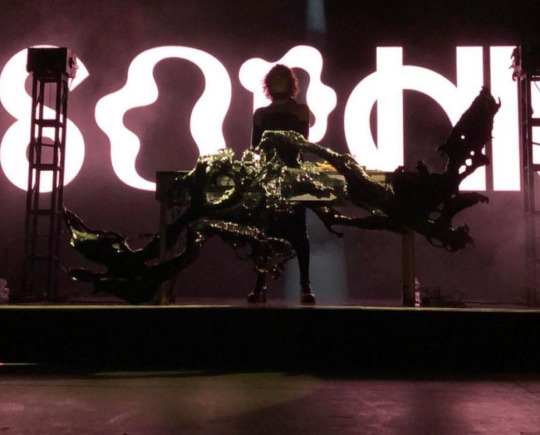
All my friends keep asking me ‘Are you happy?’/ Happy as a girl can be! Are you happy?
In 2017, I wrote for The Singles Jukebox that SOPHIE’s single “It’s Okay to Cry” was proudly, explicitly, beautifully artificial, and that its hyperreal video in which the artist danced topless in a synthetic rainstorm felt something like paradise. I said that its unreality didn’t matter to my emotional response. I agree with most of what I wrote, but I take back the last part. The unreality was, in fact, central to how SOPHIE’s work makes me feel.
SOPHIE’s breakout single, “Bipp,” posits, “I can make you feel better — if you want to.” Accompanying that melody, low bass tones rev and ripple, while high sounds bubble and bounce; there’s a feeling of elastic grace in its movement, like each sound is a molecule colliding into others. The adjectives critics reached for when it was released always carried that element of physicality. Patric Fallon writing for Pitchfork called it “sticky” and “rubbery”; Boomkat’s product description of the vinyl single compared it to “sugar-glazed silicon”; Killian Fox for the Guardian described the song in 2016 as “an elasticated squelching noise with a helium vocal on top.”
These themes pop up again and again in the writing around SOPHIE’s work. It’s rubbery, it’s sticky-sweet, it’s elastic, it’s mechanical, it revs, it screeches, it squeals. SOPHIE’s contemporaries, like Arca or A.G. Cook, might create music that feels alien or dreamy; SOPHIE’s music always felt like it referenced the physical world, but not in a way that you would expect music to do. SOPHIE would reference not physical instruments, but physical objects and materials.
This specific quality was integral to the work, and it was intentional. SOPHIE sculpted these sounds out of waveforms, instead of relying on samples. In an archived 2014 interview with Elektronauts, the artist talks about sound design as an exercise in defamiliarization: “The language of electronic music shouldn’t still be referencing obsolete instruments like kick drum or clap. No one’s kicking or clapping. They don’t have to!… You can just take a bassline made out of elastic and try it in metal.” In a video interview in 2018 with the German outlet Arte Tracks, the artist discusses making “sounds which cartoonize and exaggerate naturally occurring or organic sounds and phenomena, and materials that don’t exist at the moment.” One of the common adjectives used to describe SOPHIE’s work is “sculptural,” which carries the risk of casting the music as purely abstract; but it also demonstrates that SOPHIE’s sound art was also visual and tactile, while SOPHIE’s physical and visual work was purely conceived as a supplement to and a vehicle for the songs. In that same Arte Tracks interview, SOPHIE discusses the release of “It’s Okay to Cry” and the choice to show SOPHIE’s face and body for the first time in its video. Responding to the framing that this reveal was “brave,” the artist says that the intention wasn’t to create media attention by coming out, but to “use my body more as a material, as something I could express through and not fight against.”
SOPHIE married that philosophical framework to an artistic practice that prioritized movement and pleasure. The currents of kink and sexuality were central to the work — the 2014 single “Hard” opens with the lines “latex gloves, smack so hard/ PVC, I get so hard,” and in the Elektronauts interview the artist talks about synthesizing sounds for “latex, balloons, bubbles, metal, plastic, elastic,” physical materials that share a modern provenance and a fetishistic quality. On “Ponyboy,” from the artist’s 2018 studio album Oil of Every Pearl’s Un-Insides, distorted vocals bellow “Spit on my face/ Put the pony in his place.” But SOPHIE didn’t invoke sex as an end unto itself; instead, sex was an experience that could defamiliarize the omnipresent language of gender. The bridge of “Ponyboy” goes “he is just a pony/ she is just a pony/ they is just a pony/ pony, pony boy.” “Pony Whip,” from the 2019 remix album of Oil, repeats the teasing line “so I treat him like a boy/ so I treat him like a boy/ so I treat him like a pony boy” until the meaning of the phrase bleeds out entirely. The experience of physical pleasure in SOPHIE’s work has a psychedelic dimension, like activating the body allows us to move beyond the definitions that are assigned to it; like the body itself is something we continually create.
This clearly puts SOPHIE’s work in the lineage of pop and disco, genres which use physical pleasure as a means for spiritual transcendence. In a 2017 Teen Vogue interview, SOPHIE says, “A lot of the stuff I’ve done takes the attitude of disco but tries to bring the sound world forward… I’m trying to imagine what music that’s positive, liberating, weird, dark, and real could be in the present day.” In a 2015 Rolling Stone interview with A.G. Cook, SOPHIE says, “I think all pop music should be about who can make the loudest, brightest thing. That, to me, is an interesting challenge, musically and artistically. And I think it’s a very valid challenge — just as valid as who can be the most raw emotionally. I don’t know why that is prioritized by a lot of people as something more valuable.”
Disco and pop music — electronic music in general — has long been negatively associated with artificiality, as if artificiality is in and of itself less sincere or authentic. SOPHIE’s music is proudly, directly, purposefully artificial; it is also proudly, directly, purposefully emotive. In SOPHIE’s hands, synthesized sensations and materials became the building blocks of the best dance music you ever heard. The textures of real life — car engines, rubber tires, plastic containers, metal bars — are mirrored back at us in strange, sexy new shapes.
I say that SOPHIE’s music is trans, and this is what I mean. Jessica Dunn Rovinelli’s beautiful piece on SOPHIE’s work in the Guardian explains that “SOPHIE molded raw sound to make hyperreal versions of recognizable forms…. Transgender people in particular exist through self-processing: we make a body that we can live in and a world where that body can feel safe.” Sasha Geffen tweeted that “SOPHIE’s music isn’t just ‘about’ transness, its idiom is inherently trans. It traces the process of surfacing interiority.” Transitioning is a kind of inside-out alchemy — I feel a certain way, I learn to understand it, I begin to orient my life in a way that allows me to express it, other people begin to treat me differently. From the interior work comes the exterior effects; from reorientation, new pleasure and new life. Even if the change is synthetic, in the sense that I have to make it myself with chemical supplements or medical treatments or changes in clothing or requests to change the way I’m referred to, it doesn’t mean that its effects reverberate any less.
One of my favorite SOPHIE songs goes “I don’t need anyone to be who I want to be.” You can read this as a statement of satisfied self-sufficiency, like “I can be who I want to be all by myself,” but I prefer to read it like a prognosis: “I don’t need anyone else to demonstrate how to I want to exist.” To create your own future means leaving behind those who want to dictate that future, who demand control over the terms on which you live. In SOPHIE’s alchemical work, familiar sounds become new shapes, so that old structures — the pop song, the chorus, the melody, sound itself — become vehicles for innovation. SOPHIE made that process of innovation sound like the sexiest, most joyful thing in the whole world, so much so that you wonder why anyone would settle for the old and familiar.
Photo cred @corporatebigwig
15 notes
·
View notes
Text
A Talk with Nathan McCree
(this is a followup to my video on Nathan’s work, which you should watch(!), and a mirror of the Patreon post)
Nathan McCree is well-known for his work on Tomb Raider. If you go digging, you’ll find he’s been interviewed about the series several times. However, he’s done quite a lot more. I’d like to fill in some of the gaps. Below are snippets from my chat with Nathan about music on the Megadrive, what it’s like to work within limitations, and music in the future.
---
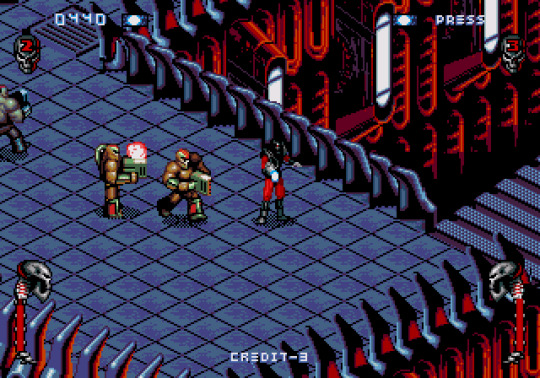
GST: Skeleton Krew's music is an oddity on the Megadrive. there's nothing else quite like it. I saw you mention that the soundscape was inspired by the graphics, which makes sense --they compliment each other beautifully. I want to ask what other influences you had in mind, if any. How much of the soundtrack was just created by just pushing strange sounds out of your tools?
NM: It's very difficult to say exactly where inspiration comes from. Mostly I am inspired by the kit I am using and the sounds they make, so in this case it was the sounds I was creating on the Yamaha chip inside the Megadrive. But musically at the time I was listening to a lot of psychedelic electronic bands like Ozric Tentacles, The Orb and lots of dance/trance/house music of the era.
GST: Now that you mention Ozric Tentacles, the arp sequences in Clockdrops have a similar feel to some of the tracks in Skeleton Krew. It's kind of striking, though I think the direction you went in is actually better realized because you seem to work so well within the FM on the Megadrive. (Hopefully the musical comparison isn't too offensive!)
NM: No I'm not offended by the comparison at all. I did learn a lot about synth patterns and textures from Ozric Tentacles, but again, without copying, I took what I learned and went in my own direction with it. It's important to always have a picture or an emotion of the project you are working on as this helps construct the music in a way which fits the mood of the product and as a result should gel the visuals and the animations together. The music in effect, acts as a kind of glue for the project which holds it all together.
GST: On the opposite end of the oddity spectrum, Astérix and the Power of the Gods for the Megadrive features nothing but classical songs. I'm curious if this was a decision from the game designers, or an exercise for you, or something else.
NM: It was a decision made by the game designer and programmer, Stefan Walker. Stef asked me if it were possible to convert 15 or so of the most famous classical pieces in history that were out of copyright protection (older than 90 years). Of course I said yes, and we set about listening and searching for pieces which fit that criteria and which would be suitable for the game. The conversion process from a full-orchestra down to a 6 note-polyphonic FM synthesizer was a challenge but a very enjoyable one, and the result earned the accolade "Best Megadrive Music Ever". I was rather chuffed with that.

GST: The soundtrack for BLAM! Machine Head is listed as released in 1995, which is before the game came out. Was this a promotional thing?
NM: Yes it was a promotional release of 300 vinyls. We sent a load to UK Clubs to try and get some club play time to promote the game. We succeeded a little but game soundtracks weren't really the thing back then so it gained little traction.
GST: That’s pretty amazing! That was late 1995, right on the precipice of game music leaking into the mainstream. (For reference, "Sega Tunes" came out in August 1996, "Club Saturn" in 1996, and Tommy Tallarico released his arrangement albums in mid-94 and mid-96)
Did you get any feedback / reviews from the clubs?
NM: Yes we did. A few were kind enough to give us some feedback. One club I remember said about Nano-Seed, "a floor-filler!". That was good.
GST: Relatedly, what is your experience with club music? Some of the tracks on BLAM! sound perfect for the era. I wouldn't expect them to be written by someone who was previously unfamiliar with club music. Do you remember any particular songs or artists that you drew inspiration from?
NM: I was clubbing a lot in the 90s. I was going to Hot To Trot in Mansfield once a month, Renaissance in Derby in between and a few other local dance venues in Derby. In the end I was clubbing every weekend. Apart from the psychedelic bands I mentioned earlier I can't really pin-point a particular dance music artist. I was listening to so much and none of it was being repeated. I was constantly listening to new tracks. It was a very inspirational time musically and on top of all this I was writing my own dance music in my spare time outside of working at Core Design. So yeah, there was a whole lot of influence that went into the BLAM! Machinehead soundtrack. Having said that, with my writing, I always try to write something which I haven't heard before so I hope there is something unique and new about the music in BLAM! Machinehead.
GST: About Swagman: This seems like the most involved orchestral soundtrack that you had created since Soulstar.
I'd like to compare the two a bit. How closely were you working with the rest of the team at this time? Swagman isn't a rail shooter so you can't match the soundtrack with the action in the levels...
How much better was your gear at this point? I'd say "it doesn't sound like you struggled with your gear this time" but you actually disguised that struggle quite well in Soulstar, haha.
NM: As you say, Swagman wasn't a rail-shooter, so scripting the music to fit the game wasn't possible. Instead I used the location of each level as my main source of inspiration, and created atmospheres to fit those - The Nursery, In the Garden, Down the Well, The Crypt for example. I had some new kit by the time I started writing Swagman. Mainly the addition of the Roland JV1080 which I had expanded with the Orchestral Boards 1 & 2 and the World Expansion Board. I also had a Roland JV90 which is the keyboard version of the JV1080. That too was expanded. So I had plenty of voice-polyphony at that point and lots of very useful orchestral patches to play with. So you're right, it was less of a struggle with Swagman, but both projects were still very enjoyable to create. With Soulstar, I ended up using quite a few saw-tooth, synth-lead patches to create the brass ensembles. They actually sounded pretty good once they were buried in amongst the rest of the orchestral sounds!

GST: Battle Engine Aquila marks a soundtrack where you were freelance AND in the distant future of 2003. How much of your gear did you leave behind when you left Core Design to go freelance? And how much of it was digital instruments on your computer at this point?
I ask the latter because, to my ears, this game sounds about as good as you can get without hiring a real orchestra.
NM: So obviously leaving Core Design meant saying goodbye to all the kit I had built up over the 6 years that I worked there, but of course I needed something to work with as a freelancer. So I spent a large chunk of my Tomb Raider money on a new studio for myself. Apart from the obvious stuff like a mixing desk, studio monitors and a PC, the decision needed to be made as to what instruments/synths I should buy. I had been really impressed with the Roland JV1080 so I bought one of those (and expanded it as before) and the synth geek in me also decided to by one of Roland's latest creations, the JP8000 - a fully record-able and controllable raw synth machine! With this machine it was possible to record the movement of every pot and fader straight to Cubase. A very useful tool for dance music, and to this day I still haven't used it to it's full potential. I also bought an Akai S9000 sampler which I used mainly for drums, so once again my orchestral setup was synth-based, rather than sample-based. So I started out freelance with this kit in 1998. When I got the opportunity to work on Battle Engine Aquila I decided I needed a bigger orchestra so I bought another Roland JV1080 (expanded again) and an E-MU Virtuoso 2000 orchestral synth which I quickly binned when the main controller knob became faulty and I wasn't impressed with the architecture of the signal path. I continued to use the Akai S9000 sampler for a few more years for electronic music but as soon as computers became fast enough for sample based editing inside the sequencing software, it too became a dust collector on my studio shelf along with other outboard gear which were replaced by VST instruments and Plugins. To this day I still use the 2 Roland JV1080s and my Roland JP8000, and that's about it. I'm not one of these musicians who needs to hide behind a million synths or new pieces of kit every month to convince people I can write music. I'm one of these guys who can make music from anything. A fork, knife, bottle, my kid's mini toy guitar, or glockenspiel. If it makes a note, I can use it, which I frequently have in my compositions over the years. I remember when I was working on a prehistoric game called BC, I used a metal electric fire which I scraped with a nail and hit some bricks with drum sticks to create the percussion sounds for the music. I don't need to buy new kit to be creative.
GST: I'm curious about what the limits are when it comes to crafting something unique. If you go too "far out," you'll have a unique song, but it might not resemble "music". Where's the balance between copying the songs you heard in the club and becoming autechre?
Same question for non-electronic music: It's possible to get unique compositions if you go to the edge of music theory, but that can also become inaccessible.
(You did seem to use odd time for the end theme of Waterlollies (11/8 by my count) though, which is always a fun technique.)
NM: Finding something new isn't about moving further and further away from music, it's about persevering with textures, ensembles, sounds, patterns and harmony until you find or create something which you haven't heard before. You have to wade through a load of stuff you have already heard until you find new waters. Sometimes that can take hours, sometimes days. You have to keep going. Adding stuff, deleting stuff. Thinking outside the box. Sometimes forgetting what you have been taught. Turning things upside down, back to front. It also helps to enter altered states of the mind when creating. This can be done in a variety of ways. Working late into the night until you are close to falling asleep for example, puts your brain into an almost dream state which helps create new things which you wouldn't normally think of during the day. This is why many creatives, and not just musicians, do their best work in the early hours of the morning. Other things can help too, drinking alcohol, but this has a negative impact on your hearing, and then of course there's marijuana which I think most musicians that have ever lived swear by! Personally for me, it's about perseverance, working at the detail and striving for perfection. Music doesn't have to be complicated or removed from tonality and harmony to be different. There are billions of combinations, it's just about looking for the new ones.
GST: One more question about the early days: Does any of the original software or source code for your Megadrive music still exist?
NM: There's a possibility that I have a copy of the programme somewhere on my hard drives but it needs a special custom built PCI card installed in your PC to work and that, I do not have anymore. You see in those days, getting access to certain elements of the games console just wasn't possible like it is today. Now you install some dev tools plugin and you have direct access to every feature of the console. Back in the early 90s we had to dismantle the machine with a screwdriver, rip out the circuit boards, making notes of the chip serial numbers and manufacturers, then calling the company and asking them for a full specification of the pin numbers and what each one did. After that, we would order the chips we wanted (or rip them out of the games console itself) and design our own circuit board which included the chips we wanted and have it all re-mounted onto a custom built PCI card which we would then install into a PC. After that, it was all about programming. We followed a similar process for the Megadrive sound chip. It was a Yamaha YM2612. So we ordered a couple of these directly from Yamaha and once we had the full spec it was pretty simple to work out how to wire it up on a circuit board. All we needed to do was to add left and right phono sockets to the output pins on the chip and send the 5v power supply to it and there you go, Megadrive synth on a PC! Of course there are the other pins (24 in total) which needed connecting up to the data bus, memory access pins, read/write request lines, interrupt request line, ground pins etc. but once we'd figured all this out it was simple enough to create a circuit diagram for the board. Once we had that we sent off the design and the 2 x Yamaha chips to a circuit board manufacturing plant in the UK. A week later our 2 x Megadrive synth PCI boards arrived. We plugged one into my PC and the other into Sean (programmer)'s PC, and we got to work coding up the sequencer. Sean took care of the machine-code level programming of the synth engine and I programmed the high-level language user interface. We had the whole sequencer up and running in 4 months. So I may have the source code and sequencer files but I don't have the hardware on which it runs. Of course I could have another circuit board made but it would take some time to get all that together again.
GST: What happened to Console Sounds / Industrial Ambiance? I can’t find it anywhere.
NM: I took the album off-line. It was available as a library album for a while but the critiques viewed it as if it was an album release and began slating it for sounding like off-the-shelf music - which is exactly what it was. It was never an album release. It was just a bunch of tunes that had not been used for anything, and I was just trying to earn some money. But when the critiques got hold of it and slated it, I took it down.
GST: That's understandable, but unfortunate. Have you considered bringing the album (or any of the songs) back on a service like Bandcamp or Soundcloud?
NM: Yes I do have ideas and avenues for a lot of my music. The first thing I want to do is to officially release all my game soundtracks. After that I'll see what's left and if there's any mileage releasing any of it.
GST: Actually, how much of your music can you release on Bandcamp? I know that the rights can get tied up...
NM: Well after the Kickstarter campaign, I am now officially a record company and publisher so I can release any of my music whenever I like. I don't need a platform like Bandcamp or Soundcloud (where often the composer/performer ends up surrendering their rights for little compensation). I don't need to do that now. I can release my music myself and retain 100% of the rights, which is a better way to go. It's been a hell of a lot of work to get to the company to this point, but the infrastructure is there now, so I'm going to continue with that.
GST: Oh, that's exciting! Do you have any idea when we can expect to see some old soundtracks released? I'm also very interested in the dance music you wrote outside of Core Design. That would be a fun throwback thing.
NM: I want to start rolling my old game soundtracks out over the next few years. I have earmarked about 10 albums which I think are worthy of release. They all require some work in terms of remastering and re-recording. Some would benefit from a live orchestral recording like Soulstar, Heimdall II, Swagman and Battle Engine Aquila to name a few, but those kinds of production are very expensive so we'll have to see how funding goes for that kind of thing. In the meantime though, I will be releasing new synthetic recordings of these soundtracks - all made using the original equipment which I wrote them on, so they will sound the same, only better! Yeah there's probably an album or two of dance type tracks kicking around which could be released. Other songs too which are still unfinished so i'll need to do a bit of work to finish those up into some releasable form. So plenty of work to keep me busy for the next 5 or so years I'd say.
GST: Where can we find news about these remastered albums? Where's a good place to find you? Is there anything else you'd like to plug?
NM: The best places to keep informed as to what I'm doing career wise is on my official FB page:
https://www.facebook.com/nathanmccreeofficial/
and also my Twitter page:
https://twitter.com/nrpmccree
As far as plugs go, please just support my concerts. They cost a huge amount of money and time to organize and I can only keep doing them if we get a good attendance. It's really important, not just for The Tomb Raider Suite, but for games music in general, and if you do like the Tomb Raider Suite album which is free to play on Spotify, please consider buying a copy. This is how us musicians make a living and it really does help us to keep going and writing more stuff which hopefully you will enjoy. A big shout out to all the fans who have supported me so far and who continue to do so - you guys rock!
9 notes
·
View notes
Text
6. Retopology and UV unwrapping
Soojung Lee, n9667598

^ Figure 1: Finished
From the tutor’s comment, I better deleted the ribbon because it will make my job difficult and harder. I do not want to make my life difficult, but I hide the ribbon rather than delete because I want to keep this for the future my own exercise and practice.
As I finished with modelling and mirror the mesh to create perfect finished model, I have to work out the face loops to apply the face rig in the future, so, this is now the time to do the retopology on the face.

^ Figure 2: Tried retopology
I tried to do the retopology to the face using quad draw tool, but somehow, it was not working. I grab the faces to check is it working or not, but it was not working.
The problem in this was I follow the faces on the base mesh rather than create my own faces to creates the rings around the eyes, mouth and etc. Therefore, I started everything again.

^ Figure 3: Retry
To started again, I deleted what I have done and redo everything I have because starting from new is the best way to start rather than undo and fixing. I slowly review the YouTube tutorial video and follow all the steps.
I started drawing the ring around the eyes and mouth as a tutorial video.

^ Figure 4: Continue
I extruded the edges of the rings in Figure 5 and slowly cover the head mesh. As you can compare with Figure 2, this is now more looking right.

^ Figure 5: Final
After all these stressful processes, I finally figured out. As you can see in Figure 7, I can now select the rings around the eyes and mouth where I need to add the rig and animate for facial expressions, but I still cannot select the faces around the head. Actually, I realised I forgot to create the ring for the headline, which means I have to do it again.

^ Figure 6: Fix the eyes
Before redoing the retopology again, I realised that eyes are not looking right, so I fixed the position of the eyes to move inside and as I change the position of the eyes, I also moved the eye wholes position as well. Now I can redo the retopology again with updated face mesh.

^ Figure 7: New retopology
I was having a bit of trouble when I was doing retopology again because this was only the second time to do after the first one. The problem I was having was a similar problem I have in the first try. I can grab the rings, but I keep selecting the all around the head. I did lots of deleting, undo and redo again and again to figure out the shape and problems. Figure 7 is the result of all the practice. This is much better retopology compare to previous meshes because I have more rings around the eyes and I can select the headline, which was not possible in the previous retopology.
I was checking my retopology in Figure 7 with the tutors, it also had the problem that I need to fix, but this was the best retopology I have done by myself, so I have no idea how and what to fix because if I do it again, I was pretty sure it will not look very different with the previous one. Therefore, I asked for help and I had a consultation with one of the tutors to help me to understand how to do the retopology and what I need to do to get a better result. As always, before we started work, we went to the Pinterest site to find the reference images so I can understand easily.

^ Figure 8

^ Figure 9

^ Figure 10
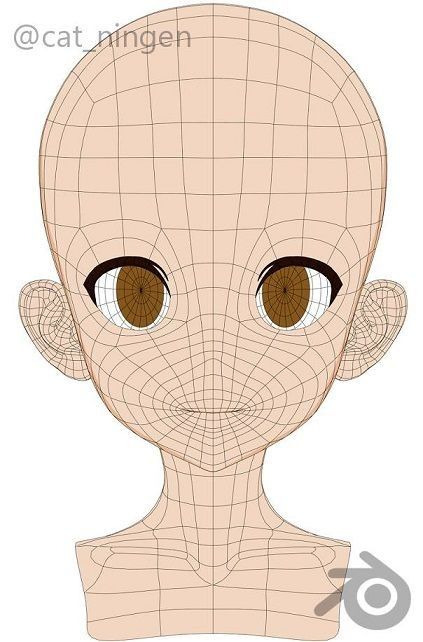
^ Figure 11

^ Figure 12

^ Figure 13

^ Figure 14

^ Figure 15
They are all the researches we have done. We were focused on anime character head rather than real human face as my model is designed in anime character style. By looking at those various reference images, it helped me to understand what and how I need to retopology, but I still have a problem with building retopology myself. Therefore, he showed me how to do and what I need to be careful about.

^ Figure 16: Rework
This is the retopology I have done with his instructions and helps. He showed and told me that the faces need to be in similar size as much as possible except the eyes, mouth, nose and anywhere there need the detail. I did not know that the size of each face has to be in a similar size that's why all my previous retopology were not looking clean and nice as Figure 16. He also told me that I have to build the eyes, nose, mouth and headline first so I can have the rings for the face rigging. He also showed me how to figure out the five angels and various things I did not know, therefore, I was able to reach to the improved result compared to all the previous retopology.

^ Figure 17: Final
This is the final looks of the mesh. I also told me to use soften edges if I want to soften looking model. I learnt various knowledge from him. He helped me and taught me the way to solve my problem and improve.
This was a seriously hard process. I did lots of mistakes and have various problems I could not solve. This was a really challenging process that I do not want to do it ever again, but I also want to try this again after this assessment finish.
I moved on to the UV unwrapping after finished with retopology.
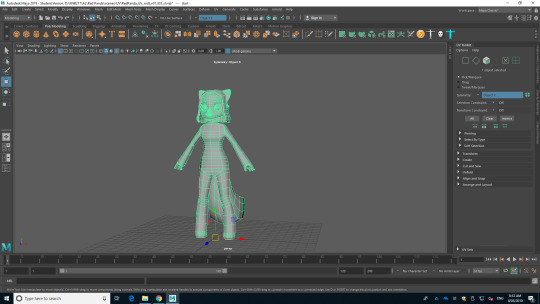
^ Figure 18: Combine mesh
Before starting UV unwrapping, my meshes are separated, so I have to combine them to keep them as one mesh. When I combined them, I also have to move the pivot because sometime it goes to somewhere different rather than the centre of the grid and character. Now, I am ready to UV unwrap the character.

^ Figure 19: Start UV unwrapping

^ Figure 20: Unfold
It became like Figure 20 when I unfold the UV unwrap without doing any cut and saw process. This UV unwrap is not right, so I have to do the cut and saw process for texture and everything.

^ Figure 21: Cut and saw manually
This is the After I cut and saw the mesh. The white lines show where and how I cut.

^ Figure 22: Unfold and layout
When I was finished with cut ans saw process, I have to unfold the UV and layout automatically. However, as you can see in Figure 22, they layout randomly, which makes hard me to texture them.
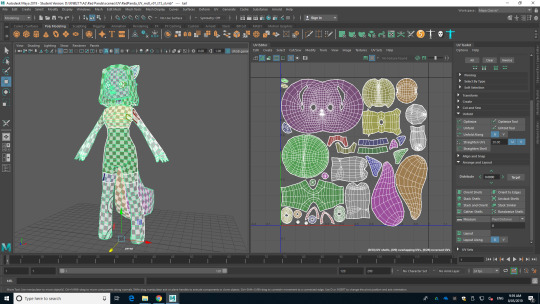
^ Figure 23: Clean up
Therefore, I moved on to layout them manually, and during this process, I also change its’ size to get similar size of the faces showing in left handside in Figure 23, so I will not have low and high resolution texture for each parts.
The UV unwrapping was not hard as I am used to UV unwrap, however, the retopology was the hardest process in this part. I have not done the retopology before and I was not fully understand the knowledge of how to build retopology. It was possible to improve until this level by getting help from tutor and the researches I have done.
Reference list
- FlippedNormals. (2018). Retopology for Beginners in Maya. Retrieved from https://www.youtube.com/watch?v=xpDWta5O3n8&list=LLmWZeSDkd1_mwsEKZ0Xs2Dw&index=4&t=0s
- Matthew Yourshaw. (2016). Maya Tutorial - Quad Draw Tool. Retrieved from https://www.youtube.com/watch?v=takFYSXDxzg&list=LLmWZeSDkd1_mwsEKZ0Xs2Dw&index=5&t=7s
- My Oh Maya. (2017). Maya 2017 Update 3: Quad Draw / Make Live Workflow. Retrieved from https://www.youtube.com/watch?v=edegRylKdzI&list=LLmWZeSDkd1_mwsEKZ0Xs2Dw&index=3&t=17s
- Next tot Education. (2018). Head Retopology in Maya Using Quad Draw Tool - Part 01. Retrieved from https://www.youtube.com/watch?v=MBJv_qLYmCo&list=LLmWZeSDkd1_mwsEKZ0Xs2Dw&index=2&t=170s
- RaveeCG Tutorials. (2016). EASY ZBRUSH - UV / UNWRAP - USING UV MASTER PLUGIN. Retrieved from https://www.youtube.com/watch?v=gQht6S7aWDg&feature=youtu.be
2 notes
·
View notes
Text
Shooting with a 21-Year-Old Camera: The Fujifilm S1 Pro
I find it incredibly fun to use older, especially unique, digital cameras both as a challenge and for sheer enjoyment.
I think part of it is psychological. With archaic cameras sporting outdated technology we anticipate subpar results, and so we focus more on what we can control: composition, lighting (when applicable), exposure, and so on — the things we should always be focusing on.
Conversely, when we have a Hasselblad in our hands, we may let go a bit in the unconscious belief that the camera can make up the difference for our lack of talent or effort. Of course, we all know it can’t.
I won’t get into the boring history of why I own a lot of early to mid-2000s digital cameras, but at some point, I found myself the owner of a Fujifilm Finepix S1 Pro — the first in a five-model line of Fujifilm DSLRs that housed some incredibly unique sensor technology that it dubbed “SuperCCD.”
Apologies for the subpar product photos. I didn’t have access to my full setup.
In the S1 Pro, the photodiodes of the 3.1-megapixel SuperCCD sensor took the form of a honeycomb tessellation, oriented in a zig-zag array rather than a simple vertical/horizontal mosaic. Because of this, the distance between cells is smaller, making for about 40% more (square root of 2 = 1.41) sensor cell rows horizontally and vertically than a regular Bayer sensor.
The camera then uses an interpolation algorithm that supposedly results in a resolution equivalent to a 6.2 megapixel Bayer sensor. The 45-degree orientation also allows for improved capture of horizontal and vertical detail. This is good because most of the world, thanks to gravity, exists in horizontal and vertical planes — however, this happens at the expense of diagonal resolution, which is where traditional sensor layouts excel.
The honeycomb design of the SuperCCD sensors.
Released in January 2000, the Fujifilm S1 Pro is based on the Nikon N60 (aka F60) film camera body (with modifications by Fuji). It logically sports a Nikon F mount and can use AI, AI-S, AI-P, AF, AF-D, or G type lens — however, only AF and AF-D lenses will autofocus. AI and AI-S lenses can only be used in manual exposure mode as there is no meter coupling.
Most of these photos were shot with either the Nikon AF-D 24-120/3.5-5.6 or Nikon AF-D 50/1.8. While the 24-120 is not a quality optic, it’s a more than sufficient match for this sensor, especially stopped down a bit — and you can stop down to your heart’s content without hitting diffraction on this camera.
I had initially gone out shooting with some superior G-type lenses, however, accurate manual focusing is impossible for me through the straw-like OVF (wearing glasses doesn’t help either) and the focus confirmation dot is totally unreliable. Strangely, I had more issues manually focusing on distant objects stopped down than closer ones wide open — the photo above was manually focused with the Sigma Art 35mm wide open at f/1.4, yet the below photo (slightly out of focus) was at 24mm and f/8 with the Nikon 24-120mm f/4G VR.
Shutter speeds top out at 1/2000th. There are several metering modes (3D 6-zone, 6-zone, center-weight), a pop-up flash and hot-shoe (Nikon TTL compatible), and ISO options of 320, 400, 800, and 1600. There is no auto ISO function, and you have to menu dive each time you want to adjust it.
File choices are JPEG or TIFF only — no RAW, unfortunately — recorded to either CompactFlash or SmartMedia. The camera certainly did not accept my 64 or 128GB cards, but I was able to dig up an old 1GB card that can hold a whopping 56 TIFF files in the highest quality mode available (“Hi RGB TIFF”).
This is easily the slowest camera I have ever used. The menu is the antithesis of intuitive; it’s mostly just a collection of symbols and abbreviations and my hat is off to you if you can guess their meaning without reading the manual.
Forget chimping. Just murder that idea and bury it. It takes a solid 31 seconds (yes, I timed it) for an image to populate the screen. Once it does, just about the only thing you can confirm is that a photo was indeed taken, though a histogram is available for more accurate analysis. JPEGs, however, are significantly faster to review.
In a way, if you choose TIFF over JPEG, using the camera is akin to shooting a bulked-up Nikon N60 loaded with a roll and a half of film — no image review, roughly 55 maximum shots, and no quick adjustment of the ISO.
The S1 Pro allows you to choose between either 3.1MP or 6.2MP output. To produce a traditional image file — which exists in rows and columns — the camera must interpolate by using adjacent photosites to generate data between existing pixels. After all, the recorded file can’t exist in the same zig-zag honeycomb pattern as the sensor. After each line is read out and the missing data is filled, you end up with twice the spatial resolution (6.2MP).
Compared to the Nikon D40, which uses a 6.1-megapixel Bayer sensor, the S1 Pro doesn’t quite reach the same level of pixel acuity. However, side by side with the 4.1 megapixel Nikon D2Hs, there isn’t much in it between the two. So, I think the real Bayer-equivalent resolution sits somewhere in the middle of 3.1 and 6.2MP — around 4-4.5 megapixels. As it would happen, this is exactly in line with the roughly 40% increase in sensor cell rows (3.1 * 1.41 = 4.37). It also depends on the scene — some benefit from the unusual sensor design much more than others.
CCD sensors are not forgiving of sloppy exposure. Pushing or pulling can quickly result in blotchy chroma noise, severe color shifts, and compromised roll-off from the quartertones into the highlights. It is not unlike slide film in this way.
The colors are phenomenally accurate and neutral out of the camera. “ORG” tone and color produce a lovely, neutral file that’s perfect for editing, and “STD” (standard) tone and color make for a pleasingly usable straight-out-of-camera file. Even with color set to “HIGH” and tone set to “HARD,” the images aren’t bombastically oversaturated and Disneyland like we often see with the “Vivid” setting in modern cameras. In fact, High Color/Hard Tone photos exhibit only a very modest bump in saturation and contrast compared to Standard Color/Tone. One thing is perfectly clear: Fujifilm was producing cameras with beautiful color output long before X-Trans.
All the images here were shot at ISO 320, 800, or 1600. ISO 400 is completely pointless given that it’s a mere quarter stop gain over base. It would be easier to just dial in a third of a stop of exposure compensation rather than clicking through the menu. I really wish there was a lower base ISO of 160, as well as intermediate options like 640 and 1280.
The camera’s high native sensitivity — combined with early CCD architecture — means that there is a noticeable level of noise even at base ISO. Thankfully, the noise is quite pleasing and mostly luminance up through ISO 800 — even 1600 has very minimal chroma noise straight out of the camera. Anecdotally, I’ve found this to be a running theme with CCD sensors — considerable noise even at base ISO, but the noise presents very favorably through most, if not all, of the sensitivity range depending on the camera. It also makes for astonishingly appealing black and white photos, especially given the finely grained texture from what is largely high-frequency noise. “Film-like” would be an apt descriptor for the results.
The considerable noise in this image is the result of bringing up an underexposed photo in post. Black and white helps cover the color shifts and chroma noise.
If you nail exposure in camera, ISO 1600 will produce remarkably great results with an unexpectedly low amount of noise for a sensor of this type and age — there isn’t much to speak of in terms of offensive noise and photos are completely usable without any noise reduction. However, at this point, you’ve lost a good bit of dynamic range and if you try to push the image in any way, blocked up patches of low-frequency chroma noise and banding immediately rear their head. There is essentially zero room for pushing the files at all if shot at ISO 800 or higher.
Quite impressively, there is almost nothing in terms of color shift throughout the entire sensitivity range — what is accurate or pleasing at base ISO will be accurate or pleasing at 1600. Again, this is something I have noticed on more than one occasion with CCD cameras — the Pentax 645D behaves almost identically throughout its ISO range.
ISO 1600, SOOC “Standard” color and tone, auto WB. Noise reduction and sharpening zeroed out in ACR. No adjustments aside from downsizing.
While restrictive by modern standards, a highly usable ISO 1600 in an APS-C camera in the year 2000 was exceptionally good. Fujifilm claimed the SuperCCD cameras to have superior sensitivity performance — the honeycomb photosites allow for more pixels to be packed within a given area and their shape more closely mirrors the circular microlenses that sit above them. I think Fuji’s assertation bears out in practice.
I would estimate roughly 7.5-8 stops of usable dynamic range, which is up against what I presume is an 8-bit ADC (analog to digital converter). Given this, along with the unforgiving nature of CCD sensors and processing latitude further limited by the lack of RAW, you need to be very deliberate with your exposure choices. Even in a scene of moderate contrast, you will almost certainly have either crushed blacks or clipped highlights.
However, like most CCD cameras, you do start to lose dynamic range quickly once you boost the ISO by a couple of stops. There also isn’t much in the shadows — modern cameras (CMOS) tend to have a lot of their dynamic range bunched up in the shadows, allowing for some truly incredible detail recovery. CCD sensors do not work the same way, and even with a full-blown RAW file, I doubt you’d find much usable information at that end of the histogram. You can mitigate this somewhat via ETTR (“expose to the right”), but with what is already a suboptimal amount of dynamic range, you’ll only have a small amount of latitude for ETTR, if any.
Oops, highway patrol got me. High contrast scenes like this are difficult – the whites are just on the cusp of clipping, but the blacks are gone in numerous areas.
While the camera’s light meter, particularly the 3D 6-zone multipattern meter, is exceptionally adept at balancing exposure in difficult scenes, the auto white balance is a duality: it’s either one of the most accurate I have ever seen or it’s the worst. Almost all the photos I took required zero tint adjustment and usually only +1 to +4 temperature adjustment. However, on three occasions the images were off by so much I’m still baffled as to exactly why.
The most egregious were photos taken about two hours before sunset in the shade — they were rendered extremely blue and about half a stop underexposed. The white balance went so far off the map that most of a plain white T-shirt measured blue values from 240 on up to completely clipped! I assume the culprit for this error is a combination of the camera’s CCD light meter design and spectral response — the infrared filter may be causing issues in certain situations too. IR filters can strongly affect the blue channel and it’s possible there was a bit of Rayleigh scattering at work.
The major issue is that without a RAW file, your options are extremely limited — those botched files required +76 temperature to correct. Such a massive shift in an 8-bit TIFF file results in horrendous noise — especially bad because the blue channel is always the noisiest — and extreme spectral shifts across the entire image. Strangely, a separate shot of a red step ladder taken five feet away at the same time required only -3 tint and zero temperature adjustment.
Using the S1 Pro reminds me of shooting with the original 18-megapixel Leica M9 and Leica M Monochrom cameras — both with Kodak CCD designs. Neither those cameras nor the S1 Pro has any tolerance for “underexpose to protect the highlights” or similar approaches in the same way that CMOS sensors allow — not unlike how slide film doesn’t take kindly to push processing. People who worry about how a camera handles being pushed five stops will need to adjust — it’ll help them in the long run so they can finally learn to stop underexposing so much.
Ultimately, while the files from the S1 Pro don’t contain anywhere near the latitude of even modern JPEGs, let alone the power of RAW, my biggest takeaway while using this camera was how much I adore and value transparency as a starting point out of the camera. In a way, the naturality of colors and tones from this camera makes it even more aggravating that the files can’t stand up to much manipulation — I would absolutely LOVE results like this out of my Nikon Z7, and every other camera I have for that matter.
My father assisting in the repair of a Pentax 6×7. In scenes like this, you just have to expose for your subject and let the extreme ends clip.
What I would love to see is a universal “Natural Color Solution” (to steal a term from Hasselblad) adopted by all manufacturers and implemented in their cameras as an option. If you want that “Natural Color” RAW file, you can have it. If you want the look that you’ve come to love from your manufacturer, you can pick that too. Aside from Hasselblad, I’m not sure what would be the risk for manufacturers to do this — other than that it would take some effort and time.
I would not call the Fujifilm S1 Pro a fun or pleasant camera to use at all. To be honest, I probably immediately deleted 99% of the photos I took while doing this review. And even among the ones you see here, there are more than a few that I am not happy with. Normally, I would not settle for posting simply passable images, but in this case, I think even the lesser photos here do have value by showing both the warts and the ornaments.
Have no doubt, this is a challenging camera to use. I’m sure my images would greatly improve with continued use, but how much I am not sure — I feel like you hit the ceiling quicker than you might imagine.
Perhaps I can follow this up with a retrospective review of 2005’s Fujifilm S3 Pro, which sports a new SuperCCD SR sensor with two photodiodes per photosite — one of normal sensitivity and a smaller one of lower sensitivity. Both are combined to produce enhanced dynamic range (and it works very, very well). The general principle behind such a design comes from the structure of the crystal coating in silver halide film. The S3 also has a 14-bit ADC and produces 14-bit RAW files! That’s just a few of the improvements, but I’ll tell you this much: the SuperCCD SR sensor does NOT disappoint.
from PetaPixel https://ift.tt/3Ambu6I
0 notes
Text
FMP Final Evaluation
Section 1: Media and Techniques
From the beginning of this project, I knew that I wanted to go down the route of interior design, I just didn’t know how I was going to present those ideas for my FMP. To find out my options I researched different methods of presenting interiors which led me to discovering things like hand-based and Photoshopped interiors. However, there was one that stood out from the rest for me, a 3D modelling software called SketchUp.

This software allows users to create models of interiors on a realistic scale, essentially creating a digital mock-up of a space for a client. This is something I knew I wanted to explore further as I hadn’t done anything like it since middle school.
Once deciding to create my Art Deco interiors, I tried to experiment with different mediums for me to use for my final outcomes. I first tried to create a hand drawn interior that was edited in Photoshop, I then tried adding SketchUp models into Photoshop and creating a room from there. Finally, I settled on creating interiors using SketchUp and importing pattern designs I created in Photoshop.
This meant I had to teach myself how to use SketchUp from scratch and get to a good enough level to create professional and realistic interiors. I overcame this massive problem by watching lots of YouTube tutorial videos and reading lots of SketchUp forum chats to collect any tips that I could use to improve my skills.
Once I had started to research Sketchup models, I noticed the mention of photorealistic rendering amongst the forums and YouTube comments. This was something that intrigued me and wished to look into deeper. Once I had done a little research on the topic, I discovered a way to make my SketchUp models into realistic renders. This was something I knew I had to use as it would make my SketchUp models look very professional and realistic.
This meant that I would also have to teach myself how to use this type of technology I had never heard of before. I overcame this issue by again watching lots of videos and reading lots of articles which eventually led me to the SketchUp plugin called TwilightRender.

One skill that I brought from a previous project was my pattern making skills in Photoshop which I had gained in my Multiverse project. I also used the skills I had learnt from last year such as composition, colour and layout to help make my surface pattern designs look cohesive, sleek and unique.
I have used lots of research to help support and push my project further. This includes a wide range of artist research, looking at multiple ways to improve the planet within the home and two case studies one of which analyses the impact of the historical context surrounding the Art Deco movement.
The most impactful research I have completed during this project was looking at composition within interior photography. This research pushed me to think outside of the box when it came to my models, using depth and angles to create renders that give the viewer a feeling of being transported to that room, instead of looking at a boring four wall room.
Section 2: Purpose/Theme/Context
In the beginning, I was given a list of fifteen themes that could possibly be my path for this project. From this list I had to choose ten to explore further, researching their definition and their context within the art industry.
Once I had explored them, I narrowed the list down to five. I then took these five concepts and researched deeper into them, looking at the historical, social and cultural context surrounding them and what my options were for final outcomes if I chose to go down that path. This research informed me of their importance in the art world which helped sway my decision on which theme to choose.
To help me narrow my options down to one, I created five pro-con lists that showed the clear advantages and disadvantages of choosing that concept. This task helped me come to the conclusion of using the concept of the environment because of its importance as a subject and its potential for interesting outcomes. It was a really close call between the environment and the 1920’s because of the number of ideas I had for both themes.
However, when my lecturer told me that I could use two concepts at once I knew that it would best suit my project to use both as it allowed me to merge all my ideas together, bulking out my project and giving me more options to explore.
The purpose of my project is to challenge the balance between style and sustainability within interior design, showing a client that it is possible to create a space that looks amazing whilst also being environmentally conscious, that you don’t have to sacrifice one to have the other.
Halfway through my project I came across the issue of struggling to balance both concepts equally. This was when I decided to focus more on the theme that I felt more important and beneficial to my project, the 1920’s. This decision helped me a lot as it took the stress off my shoulders about balancing the two themes and allowed me to put all of my energy into making more consistent and detailed outcomes.
Section 3: Outcome

This is the first of three final outcomes. This features my first colour pallet of blue, grey and gold. I think this outcome looks very stylish and sleek, this is because of its minimal and consistent colour scheme. The gold texture is placed all around the interior appearing in the mirror, lamp and coffee table, this makes the room feel more cohesive and creates rhythm. The composition of the interior photograph intrigues and draws in the viewer by including the sense of depth from the use of layers in the foreground and background. I think this final outcome meets the purpose of my project as my Art Deco wallpaper mixed with the gold texture adds a sense of decadence and luxury to the room which is the most important part of recreating the Art Deco style.
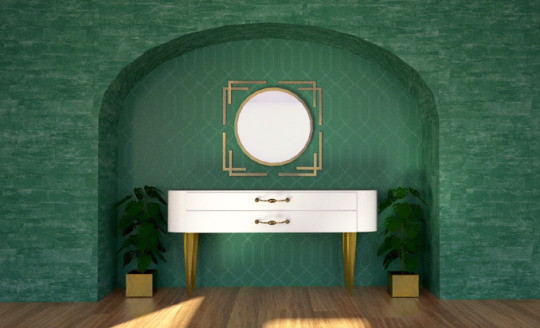
This is my second final outcome featuring the colour pallet of emerald green, white and gold. I think this interior looks minimal yet luxurious because of the simplistic furniture mixed with multiple textures. I think the use of the same gold texture from the last outcome ties the two rooms together, making them feel like a set even though they have completely different colours and patterns. The use of the smooth green stone instantly makes the hallway look more expensive and lavish. The hints of white within the stone matches the white in my Art Deco wallpaper, adding rhythm and making the space feel more harmonious. I think this outcome fits the purpose of my project because it gives off the feeling of Art Deco from the mix of a deep and luxurious colour pallet with expensive textures.
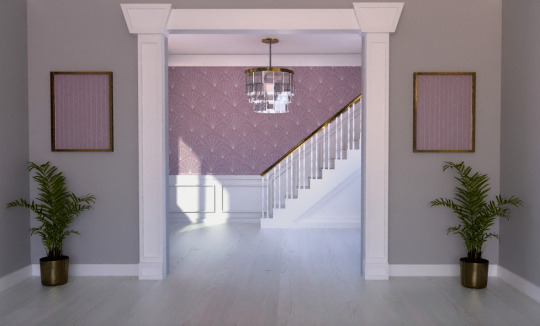
This is my third and final outcome in the colour pallet of muted purple, light grey and gold. With my last final outcome, I wanted to push the boundary of what colours fit into the Art Deco style aesthetic. I had previously done two of the most common colours found within the style and for my last interior, I thought of using a colour that isn't associated with the style. Since Art Deco is all about luxury and wealth, I thought about the colour has historically represented wealth, purple. I think the use of purple in this outcome creates an Art Deco design that is more subtle and less obvious than the other two designs. Like with my first outcome, the image composition adds a sense of depth because of the suggestion of layers with the background and foreground. The two purple frames in the foreground help to make the two areas feel more connected and cohesive as well as adding needed texture to the foreground. I think this outcome meets the purpose of my project as it still keeps the Art Deco aesthetic with the use of wallpaper and gold texture, but offers my client a more softer and subtle option for their home, in case they find the first two options too cliche.
Section 4: Evaluation methodology
I think the biggest strength of my project is my consistency, all of my designs have a distinct colour scheme and style which makes them feel like a set. I also think another strength is the clear journey that my project has gone through, showing all of my twists and turns which lead me to where it is now.
One weakness of my project is the fact that the concept of the environment was pushed to the side as I was unable to balance both themes, this makes my project feel a bit incomplete as the concept I started off with was slowly made less important as the weeks went on.
I was able to constantly evaluate and reflect on myself by completing weekly evaluations on my blog where I talked about what I did, the purpose of those decisions and the problems I had to overcome that week. This allowed me to analyse the development of my project and clearly see my progression of that week.
I also received constant critical feedback from lecturers in assessments and catch-up sessions. This allowed me to get a fresh pair of eyes to see my work and offer a second opinion on how to expand and push my project further.
The most important thing that I have learned from this project was how to create Art Deco themed pieces and how to use digital software like SketchUp and TwilightRender which will aid me in the future as an interior designer.
0 notes
Text
final evaluation
for our multiverse theme, I was really inspired by the idea of a passageway through time, or a tunnel that links the past and the future. I looked at Viktor & Rolf’s FW 2016 runway, where they used old scraps and rags from their past projects to create their garments, creating an immersive journey through moments in their career. I thought looking at the theme ‘multiverse’ in a more metaphorical, meaningful way was very interesting, so I decided to reference Viktor & Rolf’s time capsule-like garments in my own, by adding scraps and rags of black fabric to represent the ‘chaos’ side of my dress.
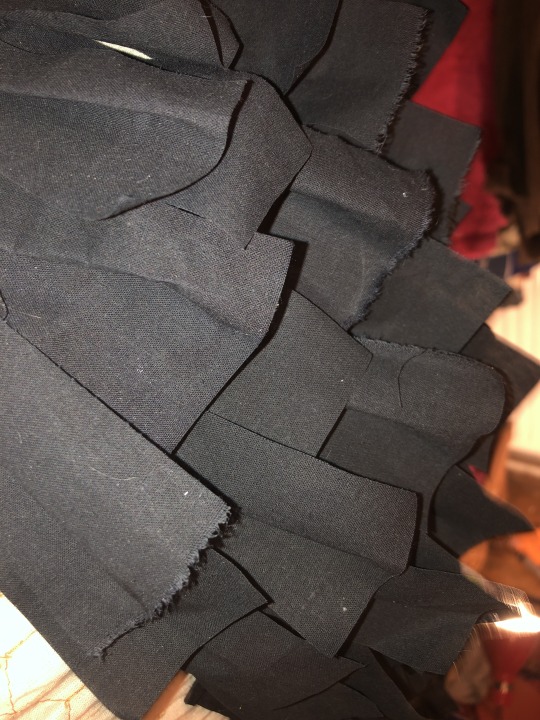
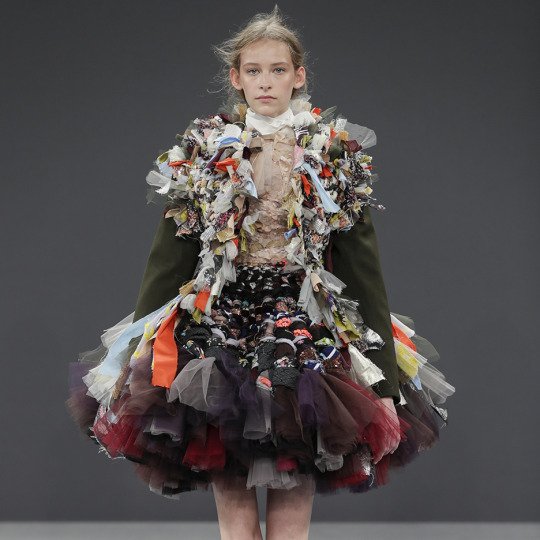
I wanted to make sure my garment didn't fall short for the M.A.R.S (maths, art, religion, science) part of our theme, so I spent a lot of time deciding how I should link it all together. For maths, art, and science I machine-embroidered a geometric block pattern all over the ‘order’ side of the dress, inspired by artist and quilt maker Yoshiko Jinzenji, whose minimalistic, yet detailed quilts communicate order like nothing else. I also wanted the geometric pattern to look like living cells of a plant or animal, with little organelles inside. For the ‘religion’ part of my theme I looked at the ancient Chinese philosophy of Yin and Yang, which is a concept of dualism, where contrasting forces are said to actually be interconnected and complimentary. this also fits in with ‘order & chaos’ because in the real world, order & chaos come as a pair, all order was born out of chaos, and you can never have one, without the other. to communicate the idea of Yin and Yang, I made sure to make opposing sides of my dress black and white, and I made the dividing line waved instead of strait to mimic the Yin and yang symbol.

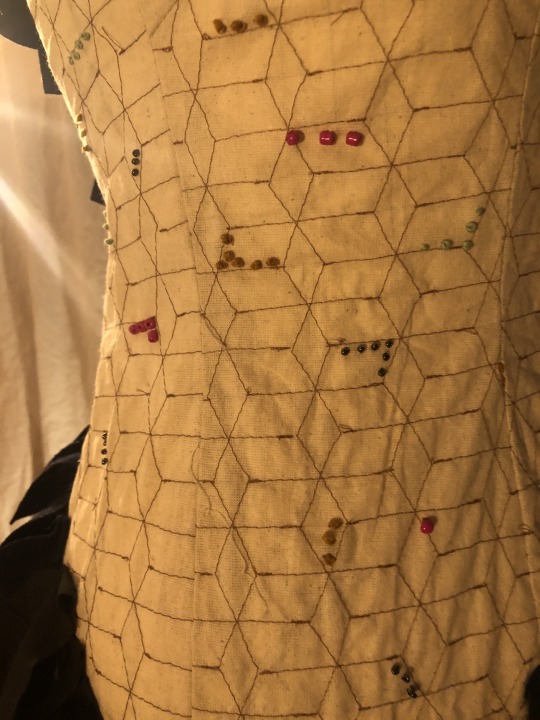
From all the 2D processes that I did in this project, I think doing an artist copy of Jinzenji’s quilt embroidery was the most effective, as it really gave me an idea as to what direction I wanted to go in the the ‘order’ half, and it also features very prominently in my final garment. I also think that the ‘fashion rough’ task really helped me loosen up and stop overthinking my designs and ideas. I had never drawn that many designs at once, and I found it really challenging at first because I wanted every design to be the best, but it made me realise that its all about experimenting, and finding out what works and what doesn't. Drawing out my final design idea was really effective in helping me decide what to do next because seeing a fully conceptualised version of my idea allowed me to go back and refine details and make it even better. some 2D processes that I didn't think were so effective for me were the mathematical grid mirrored designs we did. I didn't like the colours I used, and the lighting gave it a yellow tone which didn't look very clean or professional. It just wasn't where I wanted my final piece to go. I loved my ‘positive and negative space’ paintings, I used gouache paints which are really pigmented and easy to work with, and I spent a lot of time filling in all the details, which I think was worth the effort. they came out really clean, looking almost abstract until you notice what the paintings actually are.

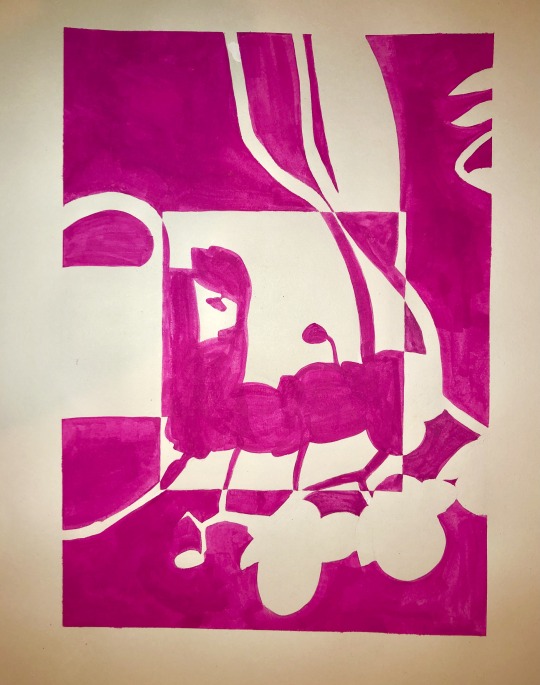
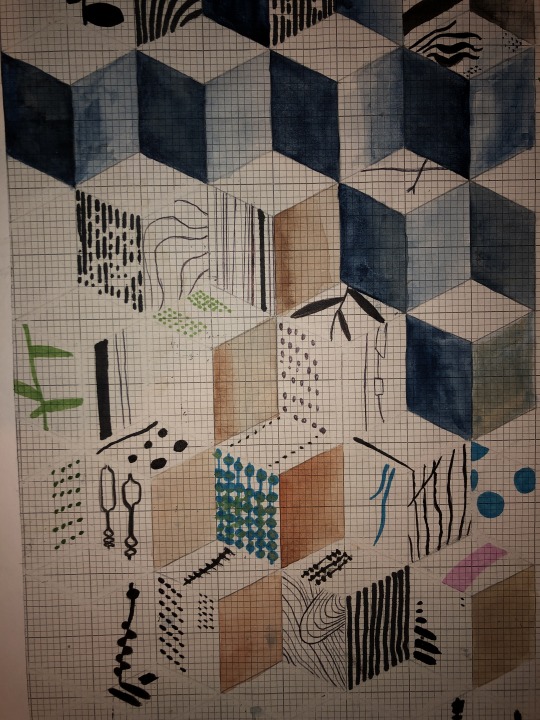

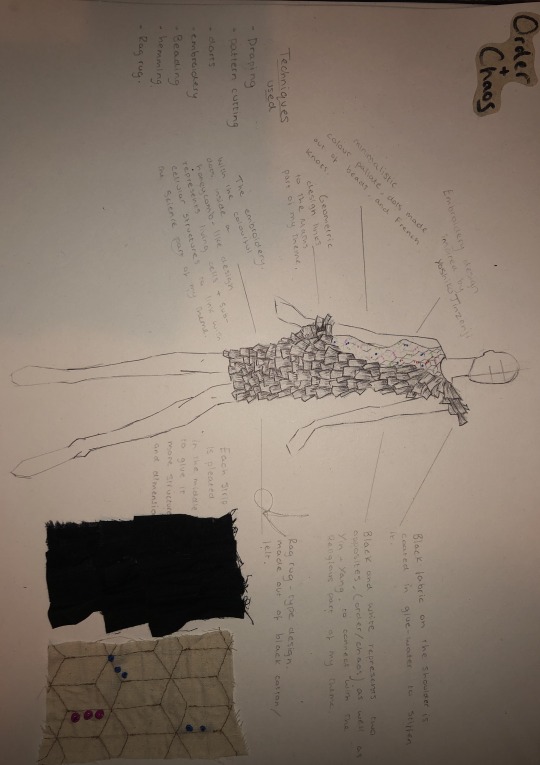
out of all the 3D processes I did in this project, I'd say that draping was the most effective. I had never tried draping before, and a chose to make a very simple dress because I don't have any experience in constructing clothes yet. I really enjoyed draping my garment, because it was really satisfying making the fabric fit the mannequin perfectly, and it was a lot easier than I was expecting. I really enjoyed the whole process of making the dress, like pattern cutting, embroidery, and sewing, my main interest is learning how to construct garments, and although this dress is very simple, I still feel like I've learned a lot. I also love the ‘interstellar wormhole/wearable sculpture’ task I did, i loved the shapes and curves the tights naturally made, I would of loved to have included it in my final piece, but I couldn't work out how to include it in a garment without it getting scrunched up because of the elasticity. Although I like how my pop up constellation turned out, I don't think it was very effective in terms of helping me towards my final piece, as I didn't explore star signs and horoscopes to represent the ‘religion’ part of my theme.


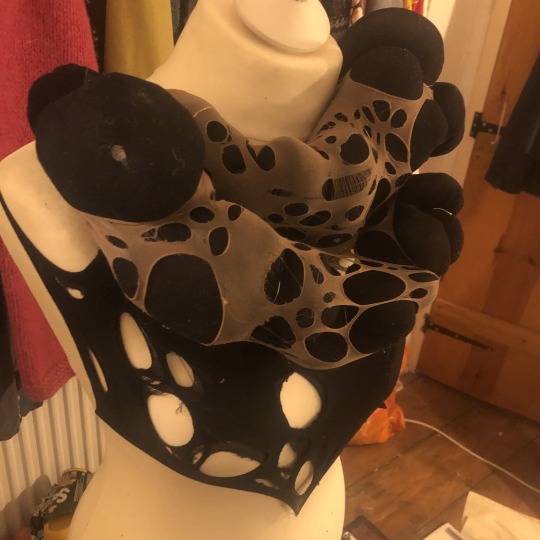
I created a video to show the process of making my final piece from start to finish by making a Tiktok. I wanted to do this because it was an easy way to cut and edit a video quickly, and add music in the background. I wanted a clear story of how the dress was constructed, which I think I achieved. I like the transitions I put into the video, I think it makes the whole process look very seamless (even though it wasn’t) and flow well.
In terms of heath and safety, there wasn't a huge concern because I didn't have access to any serious machinery or tools such as a heat press that could pose a real heath risk, but I still has to consider things such as being careful not to catch my fingers in the sewing machine. To achieve this, I made sure not to use the sewing machine when I was tired or unfocused. I pricked my self a lot with needles and pins, but there was no way I was going to avoid this, especially with the amount of beading I was doing. I also had to make sure not to cut myself with scissors, but at the time I wasn't really thinking about health and safety, its almost second nature.
I faced a lot of limitations while making this dress, especially because of covid. I didn't have any of the materials I needed, so I picked up a bag of supplies that was made for me from college, as well as buying my fabric from amazon. the fabric arrived very late, which meant I had some serious Time restraints. I'm lucky I live right next to the hardware store, I was in and out of there frequently, buying pins, needles, beads, thread, zips etc. I leaned how to drape my dress from YouTube, which meant I did have to have a couple tries before I got it perfect. the most challenging moment was when i realised I spent hours and hours embroidering and beading the wrong panel of my dress, and I had to throw it away.
I really love my final outcome, it looks exactly like the design I drew, and I think its clear that a lot of time and concentration went into creating it. I think I did a really good job of connecting it to all the themes while still sticking to a strong concept. if I were to make it again, I would add more textures and shades of black to the chaos side, I think it would look much better if it wasn't all made out of the same black fabric. I would also add more black strips on the shoulder and hip to give it even more volume. I would also love to have made it on a different mannequin, as my one doesn't have a lot of shape, and with the rag rug design, I had a hard time making the dress keep it’s silhouette.
Ive struggled a lot with time management and organisation while working a home, I find it really hard to say concentrated when I'm surrounded with so many distractions. Its something I need to work on, this was the first time I've had to do a project completely from home, and think it was important for me to see what I'm like working in a home environment so I can see what I need to change for next time. I've always struggled with committing fully to and idea or concept, because a lot of the time I second guess myself and struggle with feeling confident in my skills. this project has taught me not to take things so serious, to improvise, and that it okay for everything not to be 100% perfect.
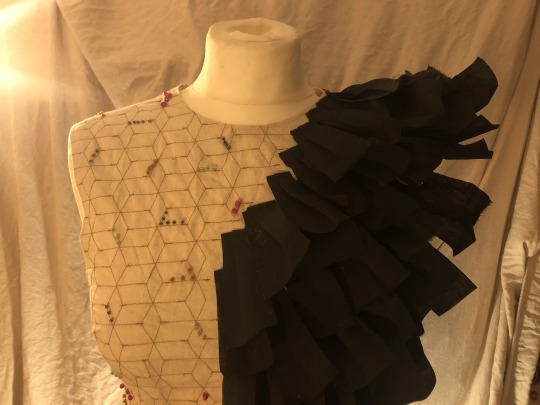


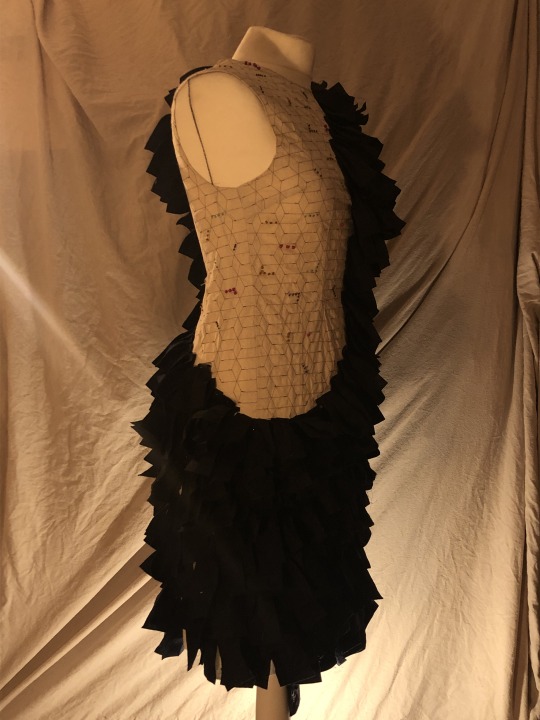
1 note
·
View note
Text
SET CONSTRUCTION #1

After my research I found myself more encouraged to get creative, yet I feel that I developed a perfectionist state of mind spending an entire afternoon and evening upon the task of designing, assembling and finally filming taking place around midnight. I definitely learnt my lesson from having Hollywood budget ambitions, yet I decided to stay determined and continue with the idea, if not improving my process and becoming more efficient overall with set construction.
As a narrative device I decided to base my dystopian society around a plant so that a sense of realism and possibility lies within the scene, for when global arming does catch up with up the human race would need to find a source of oxygen, thus basing their civilisations around a plant, giant in stature due to steroids an attribute of the humans desperately excellent care. I didn't place too much thought into what type of plant.
I just rather enjoy the metaphor of humans still corrupting for their own sustainability even when there is nothing left. The visual contrast is also powerful let alone how it mirrors modern society.

There were some elements of the footage I captured that I found very accomplishing, playing with chiaroscuro lighting and having complete control over such intricate effects is equally frustrating and exciting. But it was a challenge sitting with clay for over 3 hours trying to assemble an entire city.

I soon noticed the spontaneity of film making as I assembled my display I was completely open to any medium or inspirational thought I had. Most probably due to my patience wearing thin thus developing an panic of optimism in a rush to see the final product.
I struggled to involve a light source, with one string of battery operated fairy lights my dystopian cosmopolitan was inevitably dim, yet after tumbling with blue tac and cardboard I managed to provide a lit structure..... of poor aesthetics.
Furthermore experimenting with black marker pen in an attempt to give my display another layer of texture and further artistically evoke a realist concept. For machinery reflects that of democracy, society and industrialisation.
The following shots are taken from footage that I filmed, mostly consisting of zoom outs and establishing shots.
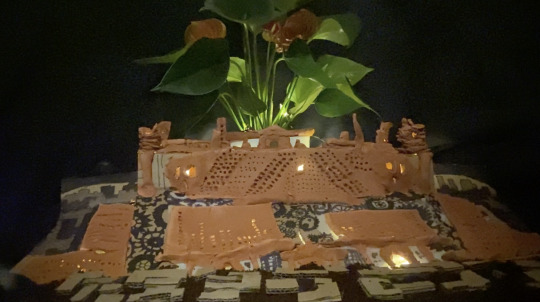
Shot with lights on, the design can easily be seen however the outcome I wish to achieve is not present. I had decided to use soil to blend my composition into darkness.
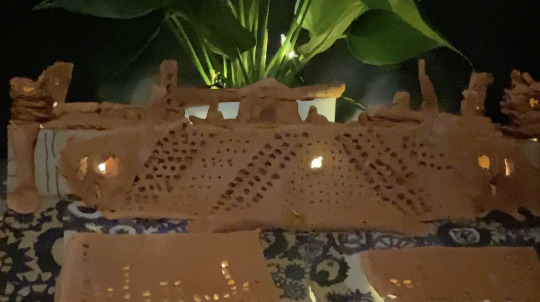
I used a method of using a kitchen fork and moving it in a circular rotation as I brought It down upon clay, I would form 4 small circles. Yet I did struggle with keeping these circles from colliding. Moreover I found it a quick and easy method of forming light displays and texture within my landscape.
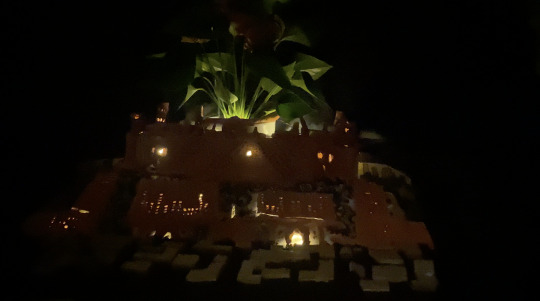
little light is displayed when shot from this angle, yet this shot has the most depth. I realised at this point to build the next rendition of my set ups a table and not the floor so that I had more freedom with shot levels. I decided that I definitely needed to work with a reflective material within the second round.

After colour correcting I was finally comfortable enough with an image to go to sleep. Still aware of all the improvements I had to make.
0 notes
Text
Final Font Sculptures Process Explanations
Final Font Sculpture A - ‘’Sharingan’’: For this sculpture, I decided to use the number 9. At first, I wanted to go for a flower design, but as I went on, I realized it looked more like an eye. So, I made a semi-circle of 9’s and used the mirror tool and copy-pasted it in order to get a round shape. I used the round sculpture and copied-pasted it in the middle and around the first shape to add more details and then I added the little pupil part that is composed of inter-crossed 9’s. I also used the same little sculpture around the pupil area to add even more details. Then, I thought it was missing a bit of detail and dimension, so I added a radial blur to both of the exterior shapes to expand the black colour. When my basic shape was done, I thought that a little bit of colour was missing so I tried many different colours like green and blue, but I didn’t like it because I felt like it canceled the neatness of the pattern. That’s when I thought about a Sharingan from Naruto so I realized that black and red could look very cool together. So, I changed the stroke colour to red of the little inter-crossed 9 sculptures and increased the thickness a little bit.
Final Font Sculpture B – ‘’Falling Into The Ocean’’: For this sculpture, I used the letter V. I started by stretching and copy-pasting the letter and I used the mirror tool in order to create a sort of ‘’X’’ shape. Then I copy-pasted it many times in order to create this mosaïque and it made me think of stained-glass. In order to add glass effect, I used the stained-glass texture and I zoomed it so that the design was not too defined. I also added a blue gradient effect to make the design look like glass a little bit more. Next, I added a dark blue stroke and played with its thickness until I was satisfied with the final design. Finally, I wanted to use the symmetry of the mosaïque to make an illusion effect, so I added a radial blur effect.
Final Font Sculpture C - ‘’Bright Like A Diamond’’: For this sculpture, I used the letter L. I wanted to make a specific and neat shape, so I decided to design a diamond with the letter. Then, I wanted to create dimension, so I simply used the anchor point tool in order to stretch the L’s and to make the lines pointier. I started up by doing half of the diamond and then I copy-pasted it and used the mirror tool so that I could keep everything symmetrical and that was really important for my diamond to look good. Finally, I wanted to make the diamond look shinier so I used the blue gradient tool and I made sure to not put any strokes (outlines) so that I could keep that soft and simple looking diamond.
Final Font Sculpture D – ‘’Fly Like A Butterfly’’: For this sculpture, I used the number 3. I decided to make a butterfly wings with the number and I wanted to give myself a challenge and play more with the anchor point tool. Basically, I played with the anchor points of the 3 until I was satisfied with the shape of the left wing. Then, I copy-pasted and used the mirror tool in order to finalize the butterfly shape. Next, I copy-pasted the shape and scaled it to make it smaller and I did this process twice so I could be able to add different colours to the butterflies. I chose different colours like blue, purple and turquoise to create good colour combinations. Finally, I used the radial blur effect to sort of mix the colours to give the butterfly wings more dimension and to make them look more beautiful.
0 notes
Photo



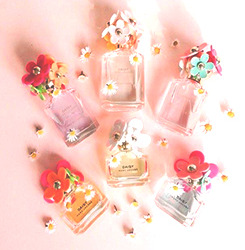

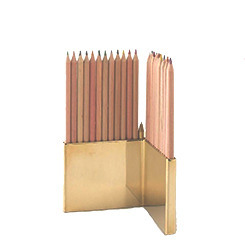

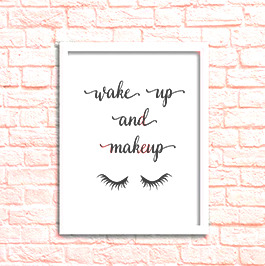

Practice Challenge 1
((Well, here it is, finally!! I know it is long, but maybe you will like it, I hope so.))
The promise
“…plie, releve, plie, releve…” I was listening to Miss Dorothy words as she was instructed the ballerinas to do the correct positions. I raised my glance from my sketchbook to verify the details on the blonde lady’s tutu; the texture of the tulle had to be properly capture in here, as well as the subtle folds that make the outfit look so feminine. The gratifying whisper of the graphite as it strokes here and there has always been one of my favorite things about drawing; it’s just as if the pencil has his own dance on the paper that once was blank.
I was there again, sitting on the flat wooden floor in the corner of the big white room. Even though I always have been way better with portraits, I had decided to practice making some complete body drawings. I just needed a good sketch to keep the image on my mind and then make it come to life in my free times at home; those times when my mother lets me breathe from all the runway rehearsals and photo shooting sets.
“That would be all for now ladies, I will see you all at our next class” Miss Dorothy paused the classical music in the middle of a violin solo, while the young ballerinas started walking towards the dressing rooms, braking the peace of the room with their voices.
Wait, what?! I was going to be here just a few minutes. Loretta is going to kill me.
I stood up as if something in the floor suddenly had pinched me and put my sketchbook and pencils back in my purse as quick as I could.
“You lost track of time again, don’t you, pretty girl?” I turned to see the thin, tanned skinned woman with the simple black dress and leggings. She has a sarcastic little smile on her face.
“Yes…! Thank you for letting me in, again, Miss” I answered. She nodded. She was a kind but strict person. I have always wanted to be part of her ballet class, but my mother never let me try; the day she found out I signed up without her permission and that I used to spend my Saturday afternoons there, she showed up making a scene in front of everyone! Since then, Miss Dorothy had never let me sign up again. It wasn’t like she was afraid of my mother, she was just a refined and pacific woman, that had no need to be involved in those kinds of problems with anyone; I didn’t want to cause her any problems either, so, I was absent for a long time, until I consider the danger had passed, and beg her to let me stay at least in one corner, quietly, just to do some sketches. A week ago, she finally accepted.
Although, I was never safe, never free. Having a high caste in this country had a price to pay, and a big one. Several eyes following you at least 3 days per week. I’m talking about the media; paparazzi, reporters… A picture of her daughter with the Dance Academy as a background wouldn’t be my mom’s favorite.
Before getting out of there I put on my sunglasses, the heels I took off when I arrived in order not to scratch the wooden floor and pulled the edges of my gray hood further over my face. I knew it wasn’t the best disguise, but it had surprisingly worked for a complete week, I also knew that ritual was pathetic, but every time I remembered all the reasons the media had given me to avoid them, I forced myself to ignore the embarrassment.
The media “love” my mother because she gave them drama and juicy news back when she was a selected; and now she is a famous and successful fashion designer, so, they can’t ignore her, even if they wanted to. But me… the fact that my personality isn’t like Loretta’s seemed to disappoint them. The good thing is some of them were creative enough to made up things about me, others just liked to have fun calling me “hypocrite” every now and then… No matter what I did, they were never content with me.

“Hey, Loretta, I’m here!” I greeted my mom as I entered to her office. I had to run into thousands of photographers, magazine staff and a big bunch of skinny, narcissist, superficial… people to reach her. I have to mention that I had been part of that bunch since I pronounced my first words, but for a change, I had never fit in it.
Everything was being settled for the new autumn/winter collection to come out to the world, so, the place was a chaos. It was always a chaos. Before this one we had the “creative chaos”, my personal favorite, when you can see all kinds of fabrics of many different colors on every table, people around my mother trying to make the best suggestion to impress her, people sawing some details on the unfinished dresses, assistants running from here to there, and, the best part, beautiful sketches of all the designs, posted on every wall… I liked that environment, where you could almost touch the ideas floating in the air and then you see them turning into beautiful clothes.
I can’t lie, Loretta was one of the best fashion designers in the whole country, maybe even in the world. I mean, not for nothing she was a very famous woman, although, being part of the -now- King Spencer selection could have helped a lot!
“You are late, hun” she said scowling, while she was fixing the sleeves of a tall brunette girl; she must had been new, because I didn’t recognize her.
“I know, sorry. I had to stay late at the school to do some… project, but Peter drove as fast as he could” Pete was my driver and bodyguard. He and I had an agreement, he wouldn’t tell mom about my visits to the Dance Academy and I would let him use my car for his personal use, twice a month on his free days.
I kissed her cheek and she gave me a fake grin, a sign that she wasn’t convinced. “Well, then, what are you waiting for!? Nancy is waiting for you”
I sighed, relieved that she didn’t react like I expected. Actually, she had been acting surprisingly indulgent, lately; and I wasn’t sure if that was a good thing.
I entered to the makeup room and noticed that Nancy suddenly hide something behind her back as soon as she spotted me. She waved at me with her free hand.
“What are you hiding from me, now, Nancy?” I asked to my young, personal makeup artist.
“Nothing, Miss. Just wanted to keep this magazine I liked, to cut some hot guys from it” She answered with a nervous tone, fanning the magazine in front of me as it had no importance, but when I noticed the name of it I understood what she was trying to hide.
I scoffed a smile, moved by her failing efforts to protect me. “…Girl! I receive almost all the magazines of the country and even international ones at home every week. I’ve read the article this morning. There’s no need to hide it” I acknowledged, sitting in the chair in front of the big mirror, as straight as I could to show my strength.
The magazine contained the announcement of my ex-boyfriend engagement with a French actress, Arlette … something. The news shocked me, but only because it had been just a year since I rejected his offer to run away with him and travel the world together.
“Are you alright, then?” She asked in a shy tone while she was preparing the face lotions, brushes and makeup to start working on my face.
“Yes, I am. You know more than anyone that we ended in good terms, and surprisingly, it wasn’t that hard to let him go. The problem still is…”
“I know.” She interrupted. Nancy was the closest I had to a friend, sometimes I feel like the makeup sessions are more like therapy for me or maybe a confessionary. We had discussed the Dylan situation before. After he left I was upset, but he wasn’t the reason. I was upset because I hadn’t had the courage to run away, to go to an adventure and leave this… good, but not satisfactory life.
We remain in silence for some minutes while she cleaned my skin with an oiled product that had a peculiar citrus smell “Besides, there are tons of better guys out there. This could be a perfect timing to be single” Nancy continued, handling me a magazine which read: “Nathaniel Schreave, Illéas most eligible bachelor. Ready for the selection?” on the cover it showed a very good picture of our Prince, he looked very handsome.
I raised an eyebrow glaring at Nancy. “What? I know you like him. Once you said you admire people that has real power and stays humble, like him. I remember it, because I was thinking: What I admire are his nice abs. But your reasons were good, too”. I tried not to laugh at her words, failing.
“I had read this magazine, too, and, you know what? … I have been considering this since then” I said smirking. She grins. I looked down to the magazine on my lap, again “I wonder what she would say” My mother hated the royals for a simple reason. She couldn’t be part of them.
“Oh no! Not again!” Nancy said raising the volume of her voice and leaving my eyeline unfinished. “You can’t lose this opportunity too, because of your fears!” A frustrated look appeared on her face.
I suddenly feel annoyed. How dare she talking to me like that. “Hey! Watch that tone, Nancy!” The true was that the only reason I felt offended, was because I knew she was right. She looked down at her shoes ashamed and disappointed at the same time and then continued working on my face.
I spent the next 30 minutes of silence meditating about what she told me, about the selection, about how I was going to fix this…
“You are ready” She said with a barely audible tone. I stood up and brush my shirt with my hands, even when I knew it was as clean as it could be. I opened my mouth to speak but she did it first. “Look, I’m sorry. I shouldn’t have to talked to you like that. It’s just… I think you’re kind of nice and I don’t want you to have anything else to regret…”
I half smiled “Thank you… I’m sorry I shouted at you. I didn’t have to take out my frustration on you” She nodded and gave a grin. “Also, I already took my decision about this selection thing.”

“…and I also think it will be great to experience what you once lived… Ugh no! This doesn’t sound convincing, does it?” I asked Moe. He was looking at me with his little bright black eyes. I was sure mini pigs are easier to convince than Loretta Castello. I had been rehearsing my words for almost half an hour inside my room. It had been a long day at the fashion studio, but I didn’t want to prolong this anymore. I sit on my bed, holding the application letter in my hands. I realized it doesn’t matter which words I use, she will never say yes to this, but I don’t care, this time I will do what I want to do. I filled the letter with all my personal info and when I finished I felt determined to talk to her.
I was walking towards my door when I listened to a knock on my door “Are you still awake, bambolina? She asked with a sweet voice. The one she used when she’s going to ask me to do something. Like that time when she asked me to be part of an underwear photoshoot at 5 am at the theme park. The good thing was that time I had the opportunity to negotiate my art classes.
“I need to talk to you” she added.
I kept the application letter in the first drawer of my desk and opened the door. “Yes, I’m still awake, come in” I invited her, although she was already inside my room, sitting on the edge of my bed. She patted the bed at her side for me to sit with her.
“Okay, what is it now?” I said with a smirk as I took my place beside her.
“Don’t say it as I always ask you crazy things, Estefanía!” I scoffed and make a sign with my hand for her to continue.
She took a deep breath as if it was hard for her to pronounce the following words. “I think you should apply for the selection” Loretta most have noticed the shocked look on my face because she tried to justify her words “… before you say no, just listen to me for a second. I think you have not entirely recovered for that break up you suffered with Dolan, and...”
“His name was Dylan, mom” I corrected her, still surprised by her words. She never showed much interest about that matter. The day I told her about it she just hugged me tight and said “I told you so” and she never mentioned it again. I guess she just wanted to give me space.
“…whatever! That jerk doesn’t deserve to be remembered. So, I think you should take this opportunity to heal and to try to get a new love” She conclude.
I couldn’t believe my ears. I thought she hated the royals, since Prince Spencer eliminated her from his selection. “That arrogante, privo di tattoo…” She always shrieks, even when I have read a whole different story in the magazines. With all she did and said about the other selected on the interviews, I was surprised she didn’t get kicked out sooner in the competition. She had been trying hard to change since then, but something in her words just didn’t fit fine, this time, but I wasn’t going to miss this opportunity.
“Hmm… I think you might be right, mom, luckily I last as much as you, there” I said in a reflexive tone. “Sure, why not? I will apply!” I agreed before she changed her mind.
“Estefanía, take it for me when I say, those girls will do whatever it takes to win… and you have to promise me you will do the same! No matter what, you have to fight hard!” Her tone was scaring me, it’s like something had possessed her.
But 5 seconds ago, she was all sweetness!
When she saw my terror face, she changed her tone “…I’m just telling you this, because I don’t want them to hurt you, bambolina” She said pulling my head closer to her shoulder and stroking my curly hair. “Just promise me you will do it” I didn’t like that tone or what she was suggesting, that wasn’t my idea to apply to this competition, I just wanted to meet Nathaniel and get the opportunity to know him more; also, the experience sounded appealing, I could finally meet real friends, real people, and in the process, I could show the Illéans I wasn’t the superficial, hypocrite girl that the media had made them believe. But this wasn’t the time to argue with Loretta, if making a simple promise was what it takes for her to let me do this, I will do it.
“I promise”
6 notes
·
View notes
Text
(REVIEW) Pain Journal Issue 3

In this review, Maria Sledmere draws out the material poetics of intimacy, glimmer, memory and salt in issue 3 of Pain Journal, from Partus Press, asking what kinds of dream-writing and ecopoetics we might find among the tangle, the camaraderie, the trace.
> Pain is an immaculate journal of new poetry and short, creative essays, edited by Vala Thorodds and Luke Allan, published by Partus Press and designed by Studio Lamont. Folding out the cover of issue 3, you’ll find an epigraph from Robert Creeley’s ‘The Flower’: ‘Pain is a flower like that one, / like this one, / like that one, / like this one’. Pain is a making, a sap, a sort of seedling and fruiting of where we are in the years. It likens itself to more than we’d tend to acknowledge. A blood, a fur of skin, a flower. It’s such a luxury to hold issue 3 in its peachy, matte dust jacket, admiring the beautiful type and the list of contributors. There’s an air of the covetable to Pain: maybe it’s the print quality, maybe it’s the poetry, maybe it’s the curation. I think it’s also something to do with the cover, dominated by the sans serif title PAIN: when I read this walking in the street, I make some kind of statement. It feels charged with the ambiguity of some high fashion statement, and yet what lucky readers are we that something of the contents may tell the pain — we don’t just wear it.
> Where to start! These are lush poems of communication, intimacy, sensation. Ásta Fanney Sigurðardóttir’s ‘Gleam & delicacies’ is a surreal and elliptical lyric of superstitious glimmer. Poetry as ‘a trap for the superstitions’. I find myself googling what a ‘glowfruit’ is and find some reddit discussions around the appearance of ‘glowfruit trees’ in Sims games. There’s this line, ‘I still have wild glowfruit trees. Do you?’, which feels like a summons, a challenge. Enter into this logic with me, where the one-time event of the glowfruit’s arrival has seeded the game’s eternal time. Someone comments, ‘They seem kind of random to me’. I had forgotten the magic of games and their luxurious richness and dream logic of glitches and hacks and splintered paths of narrative. Perhaps my childhood adoration of Sega and Nintendo was my way into poetry. The opening veils of an overlain world. Sigurðardóttir’s poetics have that quality of drifting between rooms and scenes, or falling between bodies and scales by one gesture of a linebreak, the slide of a button control, ‘I give birth to suns / for the morning hoax / slippery planets’. It reminds me of David O’Reilly’s video game, Everything, where you can move between a roving shrub, a celestial body and an oil rig in the space of ten minutes. What is meant by a ‘nighthaired waiter’? There is a dream-hand that extends to our proprioceptive venturing, that offers casual refusal (‘I didn’t come here to toothbrush the wolf’) by way of assembling the real and its purpose. The real which feels more like a ‘silhouette’.
> Significant, perhaps, that this poem of mirror-tricks and shimmers stands opposite Ruby Silk’s ‘Re:’, a poem that takes the banal conceit of email and pulling on tights in the swimming pool changing room to figure something of desire and its thirst. ‘we communicate drily’, the poem begins, ending with a slide on the nature of being quenched, on the question. Both poems forego punctuation, and more or less carry themselves on the turns of language: objects form a multiple syntax of moving between. Their cleanness on the page is perhaps what makes them gleam, they seem to hold their own. The gleam is present elsewhere in the issue, with Eloise Hendy’s ‘scrubland’ beginning, in the manner of Marianne Moore moving into Plath territory, ‘i too have a gleaming future. / a future like a fish scale, the eye / of a small bird’. Trauma or remembered pain is a matter of scale(s) and perception, of the body and its existential whittling, whitening. The speaker asks about whiteness, light, memory and dream: ‘all that spilt milk. all that gleaming’. You could say the gleam is metonymy for shame, the beaming cheeks, the sense of glowing or almost burning there in the situation. No capitals, a whittling. The idea of ‘nonsense’ itself, whittling down to the first gleam, its tender origin: ‘as a girl i was very soft’. The way the lines and stanzas slip, enjambed between, the idea of a passing through. The speaker offers her hurts: her fish eye, her pale appetite, her starved future, her dreams of fish bones and choking. ‘be gentle with me’, she implores. I think of this line from the film Lady Bird (2018), after Lady Bird loses her virginity under a pretence of shared experience and the boy Kyle is like ‘Do you have any awareness about how many civilians we’ve killed since invasion in Iraq started?’ and she replies, ‘SHUT UP. SHUT UP. Different things can be sad. It’s not all war’. ‘as an adult i am softer still’, Hendy writes, as though softening herself into the palest ghost and somehow becoming defiant, ‘my hand / is an arrowhead. a future / like a fish eye’.
> It’s no surprise that Pain is tinged with other existential tremors, those of the body and the world, of ecology and domesticity, of sex and dust. Helen Charman’s ‘In the pocket of Big Pig’ wears high theory cool on its sleeve as it sweeps into the muck and dirt of where we are. The movement of ‘manmade’ materials into the ‘natural’ is an aesthetic act: ‘Plastic / can holders entwine themselves around the / sea kelp — to tame and smooth frizz’. In that em-dash I feel the lines reaching out, the kelp and the twine and the human arms, the bristles. Does poetry do more than brush back the mess of the world, or tease it back into static? What are the ethics of pain’s poetic entanglement?
ecopoets try again and again to convince us of the
whiteness of the snow drift.
I like
muddy ducklings
dirty reedbeds
(Charman, ‘In the pocket of Big Pig’)
If ‘muddy ducklings’ has that childlike assonance of storybook rhyme, ‘dirty reedbeds’ feels adult, insistent, dark. The place where you tangle and possibly drown. Turning away from the pristine ‘snow drift’ that pulls us into the picturesque, an ecopoetics that continues the aesthetic throwback of nature poetry before it, this is an anthropocene poetics of living in a fraught, affectively entangled now: ‘I think we’re nostalgic for more than VHS when we / fuck in front of the Blue Planet poster misty-eyed as if / we’ll ever get to show the oceans to our own kids’. Sex is ambivalently yoked to procreation in the ‘misty-eyed’ act of fucking to get back to something primal, deep and planetary. The world as it once supposedly was and exists now mostly as mediation: scenes on tv, posters for Blue Planet. And the word ‘fuck’ for sex that feels iterative rather than tender, two bodies trying to make something of what they have, an intensified point in time and space, a mediation or trace of each other.
> A similar kind of iterative sweetness and friction occurs in Jack Underwood’s ‘Behind the Face of Great White Shark’, where some new entry to the ecosystem upsets the home, ‘Since we brought you home from the hospital / I have begged these hours to a stub’. Enter the metaphoric playground of sharks and dogs, worms, rats, beans and bananas. Something of this new love, the baby perhaps, the shark or the tender thirsty thing at dawn, is a hurt: ‘I admit I have been sick / since we met, pursuing this love-wound / like a moon beyond the windscreen’. A love you’d drive to all through the night, to arrive back where you started, chaste in your own ‘dawn kitchen’ with a moony look in your eye. I think of Dorothea Lasky’s ‘wild lyric I’, the one she discusses in her new book Animal: this playful and manipulative ‘metaphysical I’ that ‘can harness all fragmented senses of self and use them whenever it needs to’. Underwood’s I thrashes like a shark on the sick shores of a new love, a birthing tide, dark and light. An I that threatens violence, desire from all angles and limbs ‘fucking ambidextrously’; an I that ‘can keep you safe inland’, that pulls you into its glow, for this is just ‘the lesser work of living’.
> It is tricky to identify highlights from a journal where, as with amberflora (whose sensibilities resonate here), the selections are impeccable: focused, resonant, but also lovely alone. Nina Mingya Powles’ ‘The Harbour’ has something of Clarice Lispector’s radiance, pressed into a teeming poetics of its own. Its section titles add an epistolary quality, italicised as they are, ‘Dear whales,’, ‘Dear dreamer,’. Post-Arika, with all talk of Moby Dick and the mathematics of the whale, it seems these cetaceans are having a real moment. Powles’ address to the whale is elegiac, ‘I can pinpoint all the places you have died, / where I’ve buried you’. She’s putting pressure on the work of metaphor, the whale as so much more than whale, the whale as what cannot be contained, the whale that cannot contain itself. Her whale is more of a comrade, a friend:
When I looked out of the train
and saw your deep blue body and
you saw mine you stayed close to me, swimming alongside.
We were both travelling home.
What if ecopoetics, or anthropocene poetics, were something more like this surprising camaraderie? Does it matter whether the encounter was imagined or actually happened? Running through Pain is this suffering silk with its shadows and texture of echo and gleam, ‘the dream is wet skin against her hands / the fact is echolocation’ (Powles). I’ve been thinking about what the tensile ethics of this fugitive touch are: the touch of the image, the whale and the speaker on the train, the relative distance of speed and time between them, the hospitality she extends to the animal she is also. ‘I’ll show you my mother’s potted orchids’, in a world where to cross one human threshold is to know that later the sea will be deep enough for you once more. Pain asks how much of each other we need to hold. There’s this passage from Hélène Cixous’ novel Hyperdream (2006) that speaks to this:
I hear it, I hear a murmur your skin speaks, a blood thinks, I hear your thought running under the skin I hear your life thinking under the neat eternal spotless silk. I read with my life. I am torn. At the same time I am healed and glued back together again. During this time the world suffers and dies [...]
What is the murmur of our speaking skins, our thinking blood? The body that dreams? One pain can open the next, there’s a gesture of infinity, the way that Anne Boyer identifies in her ‘meditation on modern illness’, The Undying (2019): ‘My new calamity meant it was possible to feel every cell at once and, in these, every mitochondrion, and that it was possible, too, to have a millionfold shitshow of sensations in locations newly realised’. To have your body illumined, intensified, surged to the end of each nerve and cell with this searing consciousness. When I had shingles, I felt real dreams; they seemed to extend to a million tips, concentrated in clusters on the skin of my belly. Real dreams/real hurt. Is a body in pain the body that dreams the most, from her almost-paralysis in sensory excess? I think poems like Powles are asking these questions, declaring, spacing, opening up, leaving us on the brink of a blank that is its own quiet sublime, ‘everything is so !’. And if ‘the fact is letting go’, what of the fact have we been holding all along? Is this like Creeley, gesturing towards this or that flower, as a way of describing, to insist on it. Something we ask as children: does a flower or a plant feel pain? Pain, pain. There it is in the world, it just is, like a flower, or something more tiny and abrasive, salt after salt. A period.
> Rowland Bagnall’s essay ‘The Metal We Call Salt’ closes the journal with a meditation on the poetry of Philip Levine and Elizabeth Bishop, writers who ‘[address] the delicate failure of poetry to say the things which can’t be said’. This is Creeley, surely, with the flowers which stand for the shapeless pain. I’m reminded of a line from Rachael Allen’s ‘Kingdomland’: ‘the glass and salt my crooked pathway; impassable glass and salt’. The glittering remainders which excoriate the entry and exit of threshold, painful debris of the sea. This is the ‘tantalising’ poetics that Bagnall writes of, words that ‘say that they are lost for words’, words that gift and withhold by their material gesture: words that carry traces of what they may be. Salt-tanged and gleaming as glass. ‘What got revealed when the layers of leaves / Were blown backwards?’ Ralf Webb asks, in his ‘Three Sonnets’. What is it to walk over the crunching ‘pathway’ of such poems for pain, ana-cathartic as they move into, above, through, around and from the wound and its ferric sting? The essay also looks at the paintings of John Salt and photographs of Mark Ruwedel, considering how as a preservative and purifier, salt as both an archival and corrosive mineral: art as what consumes and reveals, what glints with the not yet spoken. Salt in the wound for pain will sting, but it will clear. These poems are such interfusions, sweetness and dreams, the ‘torn’: healed and suffering of a life and a world, coming over. And, for just a while, Pain will hold you together, soft in its peachy embrace.
Pain issue 3 is out now and available to purchase here.
~
Text: Maria Sledmere
Published: 5/1/20
0 notes
Text
Reflection.
Going into this project I felt pretty optimistic about it. Starting from a very different brief then what I have previously done, I wanted to look at it in a new way, I’ve never done and outdoor space so it was important for me to challenge myself. From the initial thought at the beginning I knew I wanted to do the pavilion, my original idea was I wanted to think of making it a performance space, which then changed into some colorful imaginative space. I wanted to add lots of colored glass that created a warm vibrant environment. My idea changed over time as I just didn’t feel like this was the kind of space I wanted it to be, I wasn’t making something that I would like to see in Albert Park. I sparked the idea of a performance pavilion as I have always been really into dance, theatre and music. I know that AUT doesn’t really offer a stage space for performers like this, and one of my design inspiration was ES Devlin. She does a lot of stage set designs for famous celebrities and designers. And of course my chosen artist from the Auckland art gallery Robert Jahnke and his reflective crosses. The thing I struggled with the most, was just designing a pavilion shaped I liked, this took the most amount of time, I just didn’t have a style in mind and all my thing I saved on Pinterest were so different in there own ways to be inspired by. In the end I chose a circular space as it went along with the fountain and old pavilion in Albert Park. It also is a 360 degree useable space. The mirrors were inspired by the Robert I loved how they created an endless void. I chose them to be rotatable to use the space in different ways, if there was a theatre you can use them as dividers or if they are all together you can eco music out louder. The level changing stage was to be able to make more use it could be staggered for performances or flat for dances ect also you could even have the audience in the stage and performance down in front of the pavilion. The neon changing lights add a useful addition for night time. This can be adjusted for any type of scene or vibe. The overall the feed back I got wasn’t bad, I did however not really receive more of what I wanted to hear, it felt very skimmed over when we had to present, and not much thought process or much advice was given that I could have used. Going forward I want to challenge myself more, this pavilion was definitely more of a “safe” design, not overly complicated or detailed. I want to add more I guess that be colours, textures, patterns shapes.... look at it in a more unique way.
0 notes
Text
Schoolhouse Takes over Pittsburgh’s Detective Building
About six months ago, Schoolhouse opened their third store location in Pittsburgh’s renovated Detective Building – the building’s architecture alone being a perfect fit for the brand that began over a decade and a half ago. In addition to their Portland and New York City outposts, Schoolhouse Pittsburgh carries the industrial light fixtures they’re known for, as well as a line of decor products made in-house and a small collection of highly curated goods. We talked to owner and founder Brian Faherty about making the decision to branch out further, what makes up the foundation of Schoolhouse, and what advice he might give to someone following in his footsteps.
Why did you pick this city/neighborhood/storefront?
Over the years, I’d frequently traveled through Pittsburgh for business and I always enjoyed its spirit and specific type of Americana. In some ways, it reminds me of how Portland felt fifteen years ago when I started the company. The city has the same optimistic and upwardly mobile energy. But I didn’t know I wanted to put a store there until I came across the Detective Building. Seeing this unique architecture that was unlike anything else around it, and imagining all the potential it held made me feel like I could see the next chapter in the company being written in front of me.
Where did you get the name for the store?
The name of the company has evolved and adapted with time. The original name, Schoolhouse Electric, comes from our first products: schoolhouse-style light fixtures. I’d found these cast iron lamp shade molds in upstate New York and had them returned to service to produce the same type of lamp shades that were common in homes, businesses, and yes, schoolhouses, throughout the early part of the twentieth century. After creating light fixtures to go with them, Schoolhouse Electric was a natural choice. In 2011, we moved into our current building, which is a 125,000 sq. ft brick factory, and we also added a line of home goods to our selection of lighting. At that point, we added the “& Supply Co.” portion to reflect our new dry goods. Most recently, we simplified to just “Schoolhouse,” which is crisp, clean, and reflective of the “want better, not more” mindset we operate under.
Has it changed much since it opened? How?
The Pittsburgh store has only been open about six months, and since the building is much bigger than just the store, we’ve had a few projects to tie up both inside and out. Our new sign was finally installed on the side of the building, which was the last stamp of our presence in the building. But in terms of our approach to the look and feel of the store, the clearest evolution is visible in our different stores. This is our third retail store, including Portland and New York, and each store has its own personality. Whereas our Portland store is located in a century-old brick factory that carries a long history of manufacturing and maker spirit, the Detective Building is this bold, geometric office building built in the New Formalist style.
What’s one of the challenges you have with the business?
Whenever you move to a new city, you have to work hard to establish yourself in the city and neighborhood. I always felt like there is a cultural connection shared between Portland and Pittsburgh, but it’s on us to make ourselves known in the community so that people can judge what we’re doing for themselves. Getting people in the door is one thing, but making people feel like they can linger and enjoy a cup of coffee and feel a mutual sense of belonging is a much bigger challenge.
What’s your favorite item in the store right now?
Choosing a single product might be impossible for me since I’ve put so much of myself into just about everything we release. But in general, my favorite products can be found in the Iconic Schoolhouse collection. The Iconic Schoolhouse collection is composed of our most time-honored, beloved products like the Studio Desk Lamp, the Winter + Summer Cotton Coverlet, and the Utility Stool. Every new seasonal collection we launch has a different inspiration or motif, but when you look through the Iconic Schoolhouse collection you can see the things that tie it all together into a cohesive whole. It’s sort of our visual thesis statement.
What is this season’s theme/inspiration/story?
For Spring this year, we wanted to focus on the spirit of hospitality, inclusivity, and making time to spend with friends and family. Welcoming people into your space, whatever and wherever it may be, is something of a disappearing art, but it’s something we think is incredibly important. We shot our most recent catalog in the home of a woman who has an almost preternatural ability to make people feel welcome. She doesn’t just offer you drinks, she lets you know that she hopes to catch you making your own drinks because then she’ll know you feel at home. That’s taking hospitality seriously.
Are you carrying any new products and/or undiscovered gems you’re particularly excited about?
I mentioned our Spring catalog, and the themes present there really translate to the products in the Spring Collection. The bedding, which includes the Blooming Field Family and Waffle Stripe Throw, are designed to be the perfect weight for nights that get steadily warmer. The Ion – Workshop Edition has a bright, playful color line, and its scale gives it a very personal, almost intimate feeling. It doesn’t just feel like a lamp, it feels like your lamp. On the opposite end of the size spectrum, you have the Ostara, which is this very large, friendly chandelier that emits a soft and pleasant glow through its specially designed diffuser. It’s easy to imagine people sitting under the Ostara and around a dining table, chatting through the evening.
In the Fall, we also launched a collection of products based on Pittsburgh. The Andy Collection is composed of stools, coffee tables, and side tables that all share the same tulip-shaped cast aluminum base. The Charles Side Table is another really fun, modern side table that combines oak, chrome, and leather.
What’s been a consistent best seller?
The items in the Iconic Schoolhouse collection are all quite popular. Lighting, like the Luna Pendant and the Alabax Surface Mount, are perennial favorites. People seem to really like our bedding, too. We try to use patterns and materials that play well together without feeling too matchy. Then we either make them ourselves or source them from the best makers we can find to ensure a quality difference you can feel.
What’s your process for selecting + curating the objects in your shop?
We manufacture the majority of the products in our stores, so our seasonal collections will obviously dictate what’s for sale at any given moment. But when we do choose to sell products from other makers, we have a very high bar for what we select. First, they have to align with our particular aesthetic sensibility, which can be hard to pin down but involves things that feel both of their time and timeless. A product might have been been designed in the 1960s, but we want it to also feel contemporary and timeless due to the strength of its design. Beyond just aesthetics, though, we ask some more difficult questions that start to thin the herd of products we’re considering. Does the product tell a unique story? Can it be ethically sourced? Does it solve a problem for our customers? Only products that can produce satisfactory answers to all these questions will ultimately make it into our stores.
Do you have anything from the store in your own home?
My family’s home is kind of like the testing ground for Schoolhouse products. Throughout the years, we’ve moved into homes of disparate architectural eras, and designing products that have felt at home in any or all of them is an interesting problem to solve. Most recently, we redesigned our home in parallel with the renovation of the Detective Building. This gave me the opportunity to test how certain types of lighting, flooring, textures, color stories, and materials work together. Sometimes I’ll have a custom piece built for our home which we like so much that we develop into a product for Schoolhouse. The Leo Mirror, for example, is closely related to a custom piece in our bathroom.
What’s been one of the most fulfilling aspects in opening your store?
Taking on a project like the Detective Building renovation is a huge undertaking, but it also comes with a multitude of very fulfilling moments. In the beginning, the plans unfold and you see the lines start to intersect and form a picture, which is an incredible, optimistic place to be. Then, as construction progresses, you have all the moments where something is finished or installed and it looks better than you even imagined. Seeing the core of this magnificent old building restored one day at a time is a special experience. But I have to say the most fulfilling aspect is seeing the reactivation of the neighborhood around the building. An abandoned building can’t contribute to the neighborhood in the same way an occupied building can. Seeing the lights come back on in our little corner of East Liberty has been fun.
What’s one lesson you’ve learned since opening your store?
We’ve learned that brick and mortar isn’t dead. Not only is it not dead, there’s reason to believe that people are hungry for more and better retail experiences, and it will grow in the future. People may use their phones and computers throughout the day, but in some ways, that provides all the more reason for them to want to log off and experience something in person. If you put the investment into creating a space that’s a resource for the community, people will respond.
Owner and Founder Brian Faherty
If you could give one piece of advice to someone who wants to follow a similar path to yours, what would it be?
Never underestimate the power of “we.” Nothing is easy about building a business from the ground up, so it’s important your teammates share your vision. Once you’ve selected that team, it’s your responsibility to do everything you can to help those people grow. The good news is that the more you help those people grow, the more that generous spirit will be reciprocated. That’s how you create an environment and a group that can accomplish big things.
Visit Schoolhouse at 5811 Broad Street Pittsburgh, PA 15206 or schoolhouse.com.
All photos courtesy of Schoolhouse.
via http://design-milk.com/
from WordPress https://connorrenwickblog.wordpress.com/2019/04/02/schoolhouse-takes-over-pittsburghs-detective-building/
0 notes
Text
29 Doubts You Should Clarify About Interior Design Advice | interior design advice
Photographed by Jenna Peffley for Lonny.
Famous Interior Designers – Styles of Top Interior Designers – interior design advice | interior design advice
When an autogenous artist works with a client, a bewitched affair happens breadth two claimed styles amalgamate calm to actualize a attractive amplitude that’s a product of their collaboration. Yet aback a artist decorates their own home, it is a absolute absorption of their adroitness and tastes.
As we first took a blink into Elizabeth Law’s West Hollywood pad, we felt like we took a cruise into her architecture dream. The archetypal SoCal home is all-powerful with accustomed materials, beautifully crafted pieces, and abounding with vignettes that we alone ambition we could align ourselves. While the space looks altogether styled, the use of texture and balmy accents makes it feel actually livable. Another abashing fact? She was able to cull all of this off in a rental. *Cue our aperture dropping*
As we apperceive how difficult this antithesis is to master, we had to ask Law to let us in on her architecture secrets. After all, this autogenous artist has about nailed that je ne sais quoi of Cali-cool. Read advanced to analyze the absolute home and get acumen into the South Carolina native’s curated architecture process.
Photographed by Jenna Peffley for Lonny; Styled by Liz Foster.
How would you ascertain your architecture aesthetic?Elizabeth Law: My architecture artful changes with every abode somewhat because anniversary amplitude has its own energy, story, or style. I tend to mix elements as abundant as I can. I acquisition it important to accommodate wood, glass, stone, metal, and upholstery. I apprehension added and added of a arrangement I suppose, in that I usually absorb leather, article copse that is soulful and substantial, and afresh article with aces patina.
Interior Design Advice For Using Natural Light In Your Home | House … – interior design advice | interior design advice
I mix old and new, asperous and smooth, and beat and able all calm to actualize a lived-in, curated but adequate space. When it’s abundance I accumulate it neutral, aback it’s for a applicant I like for it to reflect them as abundant as possible.
What was the home like afore you began to redesign the space?
E.L.: I was absolutely advantageous to acquisition this gem in West Hollywood and a rental no less. It was a absolute apple-pie slate to accouter but I contrarily did not accept to do any work.
Photographed by Jenna Peffley for Lonny; Styled by Liz Foster.
How is it altered alive on your own home vs. your clients’ homes?E.L.: Alive on my own home agency it’s never finished! It is anytime evolving and I adulation to aggregate things as I acquisition them. I’ve been affairs home accoutrement aback I was actually 10. The aboriginal affair I anamnesis is a admirable cottony rug that I best out with my dad on a cruise to Morocco. I still accept it.
29 Superb Pieces of Interior Design Advice – interior design advice | interior design advice
Did you face any challenges forth the way?E.L.: I created a challenge. This move was in the average of a active time and I had a attenuated window to get acclimatized so I could focus on assignment and life! So I absolutely did this absolute abode in two weeks. And by the way, it was starting from blemish because best of my absolute appliance is aback east!
Photographed by Jenna Peffley for Lonny; Styled by Liz Foster.
What is your admired allowance in your home?E.L.: My active allowance is. It has an amazing window with admirable ablaze and it is a actual blessed and adequate space. The mirror adverse the window allows for alike added light.
I adulation the fireplace, my base Samsung Frame TV — I would never put a accustomed TV aloft a crimson afresh by the way— and my comfortable atramentous covering chair. I’ve had abounding gatherings and it has been an inviting, serene altar for many!
Are there any adornment pieces with absorbing belief abaft them?EL: I accept a affair for birds and I acquisition accoutrement everywhere, so aback I saw a painting that my acquaintance Amy Wickersham did, I accomplished there was a “sister” one still in existence. It was accustomed to me as a allowance and it is one of my admired things in my house.
Priceless Interior Design Tips from Juan Montoya, Steven Gambrel … – interior design advice | interior design advice
I additionally accept a best adamant table with bottle top that I adulation every time I see it. Absolutely I could acquaint a little adventure about anniversary account so I’ll leave you with those!
How did you abbey your alfresco area?EL: Because I absorb a lot, it was important to me to accept abounding basement and a blaze pit. Contrarily it was appealing beeline forward! I begin myself fatigued to lots of adamant aback I advised this abode so that flowed accurately into the alfresco breadth with these CB2 sofas.
Photographed by Jenna Peffley for Lonny; Styled by Liz Foster.
As addition who works from home, how did you accomplish your appointment feel altered from the blow of your space?EL: Because it is physically detached, that already helps. But I capital it to be accessible and basal so that I can accept all the brainy amplitude I need. I accept my desk, a computer, a drafting table, and that’s all! I accumulate samples in a closet and it’s contrarily simple. I did a access of floral wallpaper abaft my board aloof because it’s so airy and there is no such affair as too abounding flowers.
Is there annihilation abroad you would like to allotment about the design?EL: I accumulate candles and flowers everywhere because to me it is so important to accumulate the atmosphere and amplitude apple-pie agilely and visually. I additionally accumulate palo santo or academician around. I feel that a home should not alone attending great, it should additionally feel great, aroma delicious, and accomplish you instantly relax aback you airing through the door.
Interior design with Skylight – interior design tips – interior design advice | interior design advice
29 Doubts You Should Clarify About Interior Design Advice | interior design advice – interior design advice
| Allowed to help my own blog, with this period We’ll provide you with regarding keyword. Now, this can be a 1st picture:
interior design advice online | Decoratingspecial.com – interior design advice | interior design advice
Why not consider picture above? is usually that will remarkable???. if you’re more dedicated consequently, I’l t explain to you a number of image all over again under:
So, if you wish to secure all of these great images regarding (29 Doubts You Should Clarify About Interior Design Advice | interior design advice), just click save icon to save the images in your personal pc. There’re all set for save, if you’d rather and wish to take it, click save symbol in the post, and it’ll be immediately saved to your pc.} Finally if you desire to gain unique and recent image related to (29 Doubts You Should Clarify About Interior Design Advice | interior design advice), please follow us on google plus or save this site, we try our best to give you daily up-date with fresh and new photos. We do hope you like staying right here. For most updates and latest information about (29 Doubts You Should Clarify About Interior Design Advice | interior design advice) images, please kindly follow us on tweets, path, Instagram and google plus, or you mark this page on book mark area, We attempt to provide you with update regularly with all new and fresh graphics, enjoy your exploring, and find the best for you.
Here you are at our website, articleabove (29 Doubts You Should Clarify About Interior Design Advice | interior design advice) published . Nowadays we are excited to announce that we have found an awfullyinteresting nicheto be pointed out, namely (29 Doubts You Should Clarify About Interior Design Advice | interior design advice) Lots of people attempting to find details about(29 Doubts You Should Clarify About Interior Design Advice | interior design advice) and definitely one of these is you, is not it?
Where to Find Cheap Interior Design Advice – WSJ – interior design advice | interior design advice
Simple Home Interior Design Tips – Online Meeting Rooms – interior design advice | interior design advice
29 Interior Design Tips To Incorporate Into Your Home I Décor Aid – interior design advice | interior design advice
Interior Design Tips for Beginners – TorelliRealty.com … – interior design advice | interior design advice
The 29 best ♡ Interior Design Advice Boards… images on Pinterest … – interior design advice | interior design advice
Mastering Hollywood Regency Style – Homepolish – interior design advice | interior design advice
Interior Design Advice That Always Works in Your Mid … – interior design advice | interior design advice
Vertical Blinds. Free In-Home Design Advice. Professional Interior … – interior design advice | interior design advice
Vertical Blinds. Free In-Home Design Advice. Professional Interior … – interior design advice | interior design advice
Interior design advice for kitchens | Real Homes – interior design advice | interior design advice
Vertical Blinds. Free In-Home Design Advice. Professional Interior … – interior design advice | interior design advice
Interior design advice for kitchens | Real Homes – interior design advice | interior design advice
Cottage interior design – interior design tips – interior design advice | interior design advice
Interior design advice and ideas |Decor Ideas and Home Styling … – interior design advice | interior design advice
Interior Design Advice – Home Design – interior design advice | interior design advice
Interior Design Advice – Home Design – interior design advice | interior design advice
Amazing of Affordable Interior Design Tips And Tricks At #6458 – interior design advice | interior design advice
Interior Design Advice – Home Design – interior design advice | interior design advice
Amazing of Affordable Interior Design Tips And Tricks At #6458 – interior design advice | interior design advice
Erika Ward Interiors Atlanta: Interior Design, Interior Decorating … – interior design advice | interior design advice
Interior Design Tips to Make You Feel at Home – Table Cape … – interior design advice | interior design advice
Interior Design Advice: Seasonal Inspiration | Just Fabrics – interior design advice | interior design advice
How to get interior design advice for free at IKEA | Home Beautiful … – interior design advice | interior design advice
The post 29 Doubts You Should Clarify About Interior Design Advice | interior design advice appeared first on Home Picture.
from WordPress https://homepicture.online/29-doubts-you-should-clarify-about-interior-design-advice-interior-design-advice/
0 notes